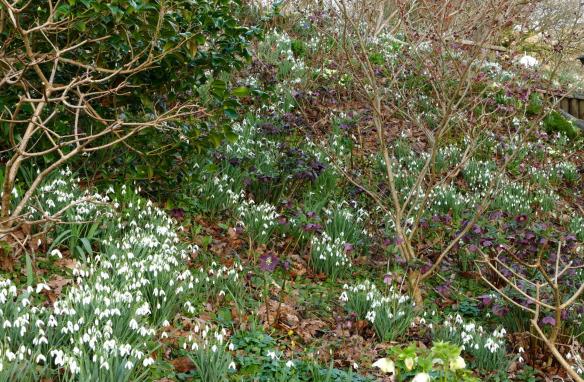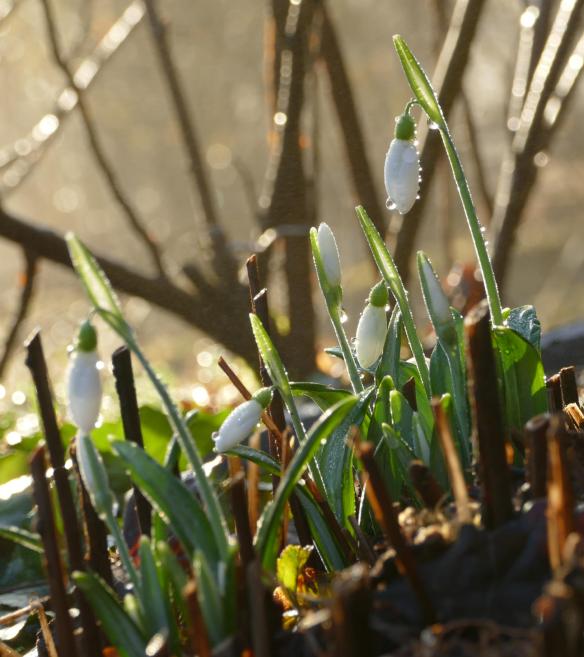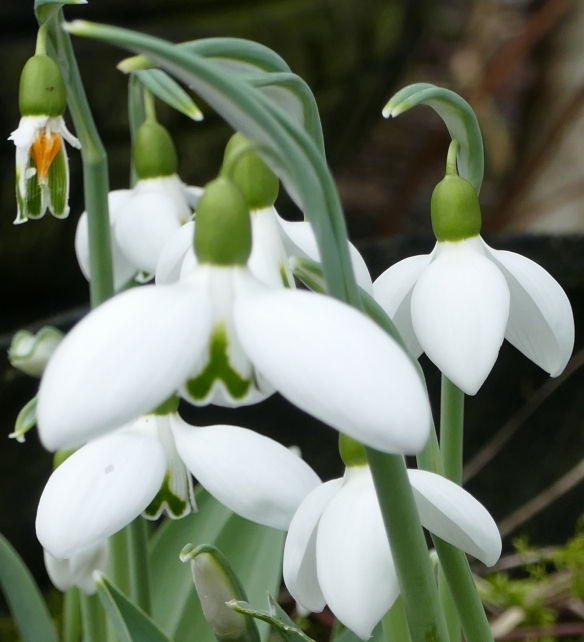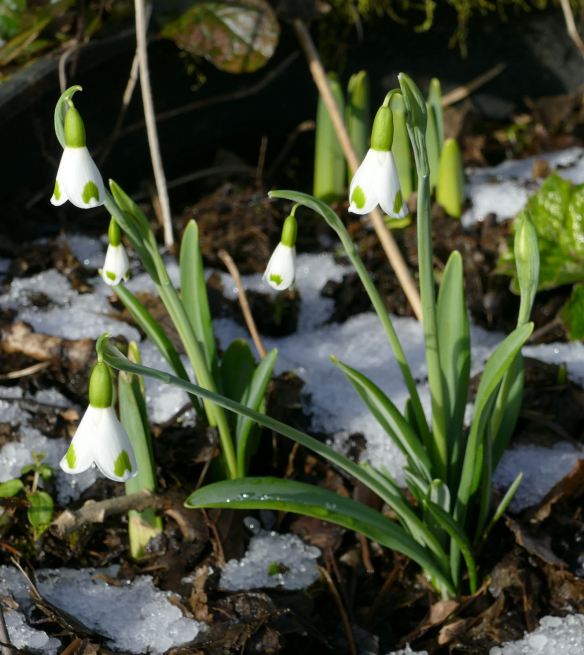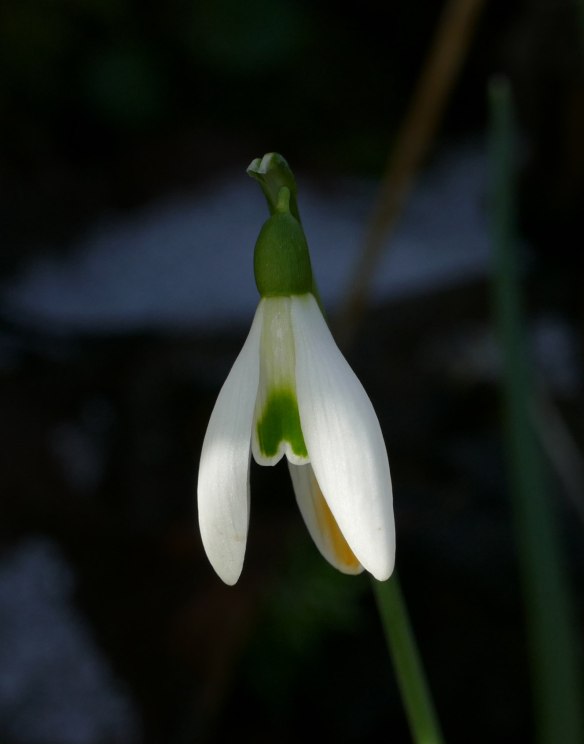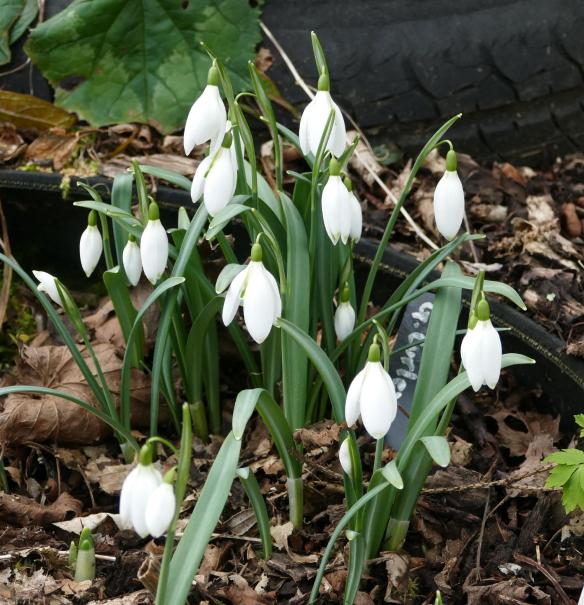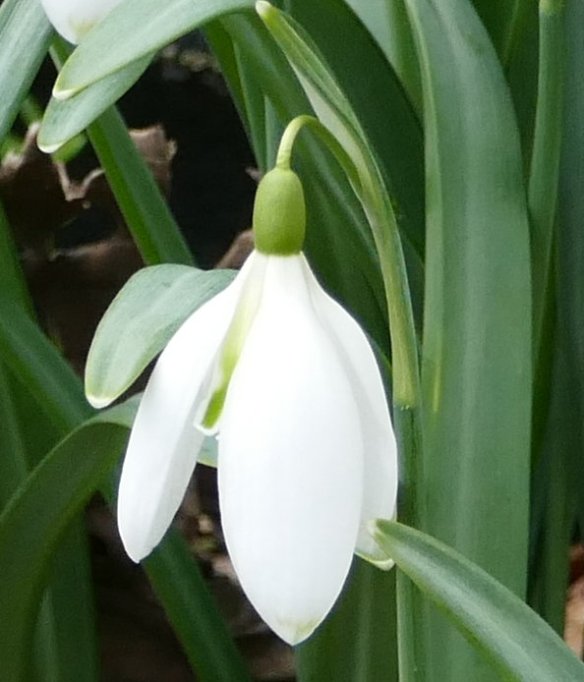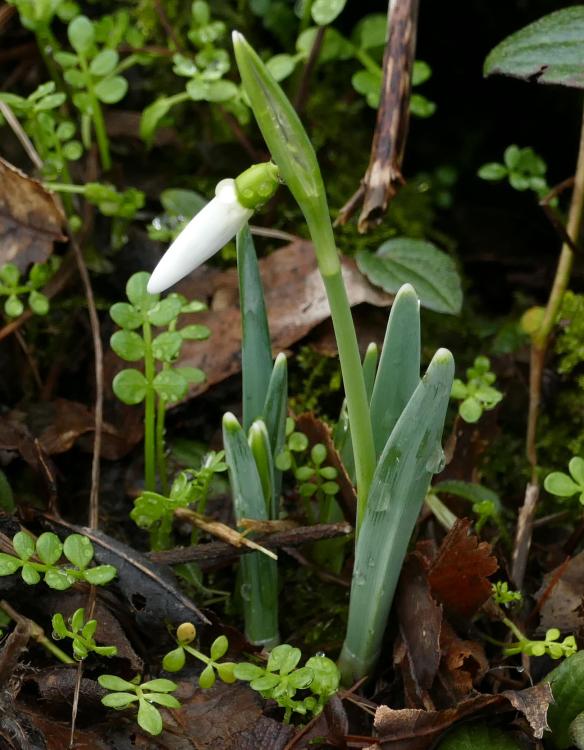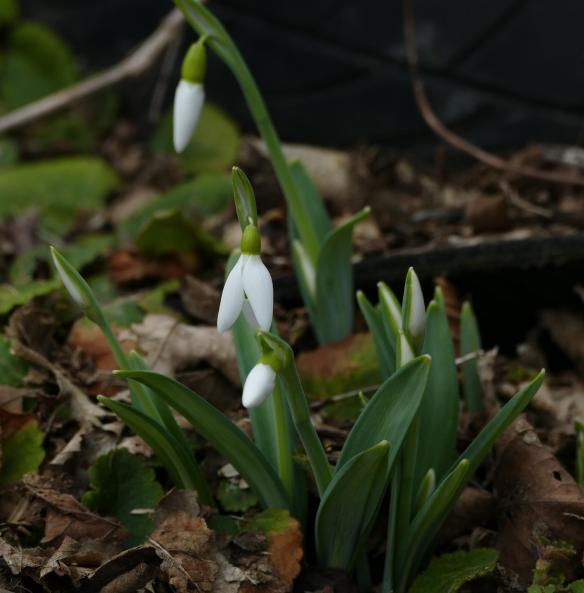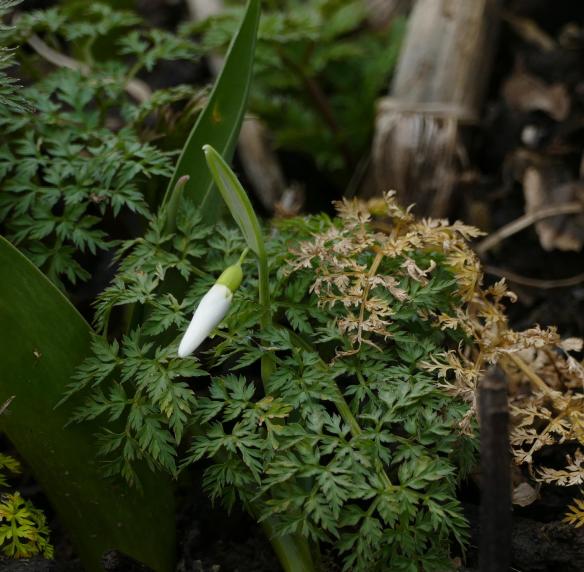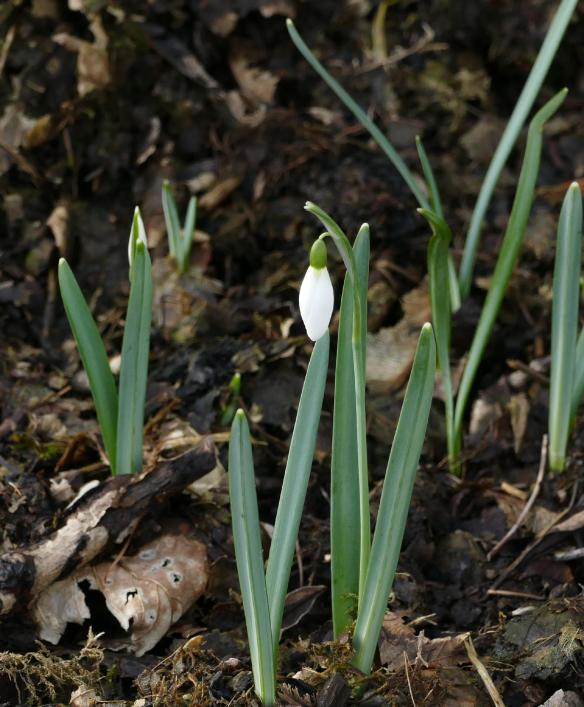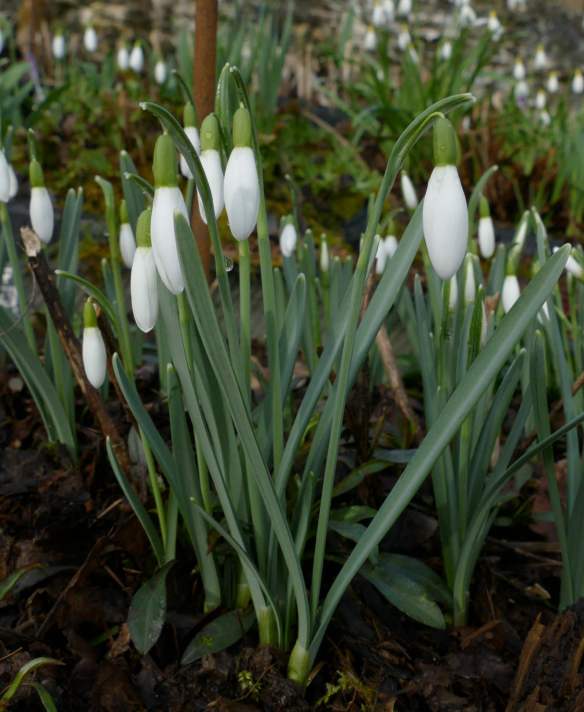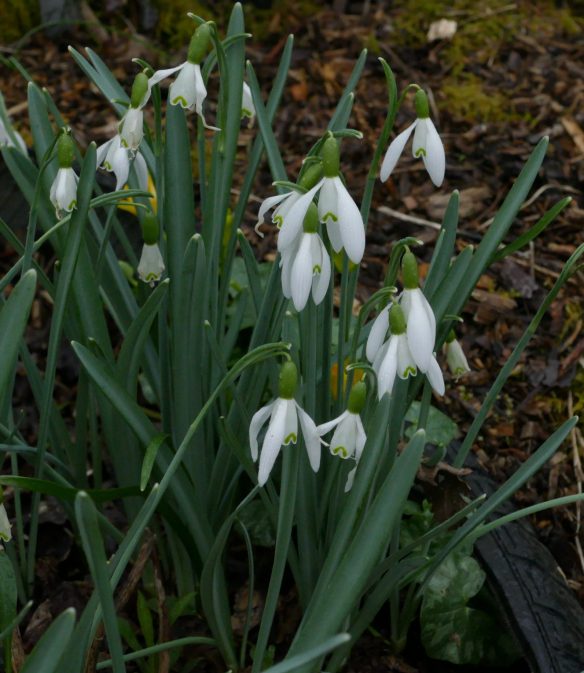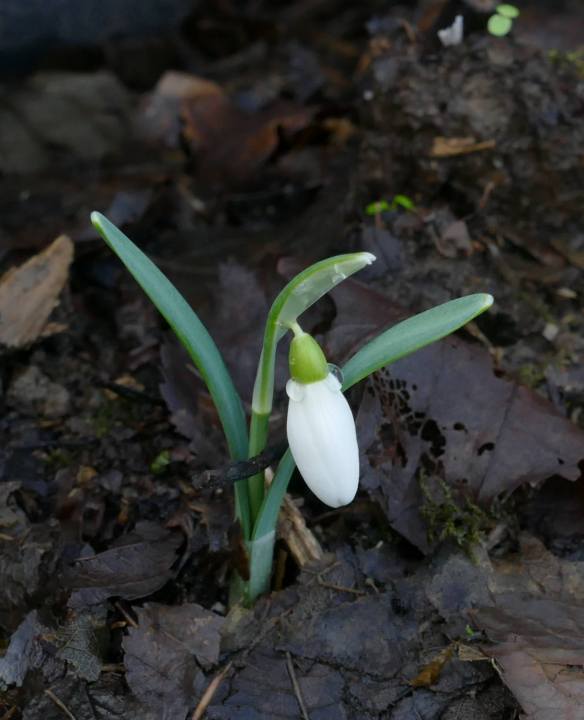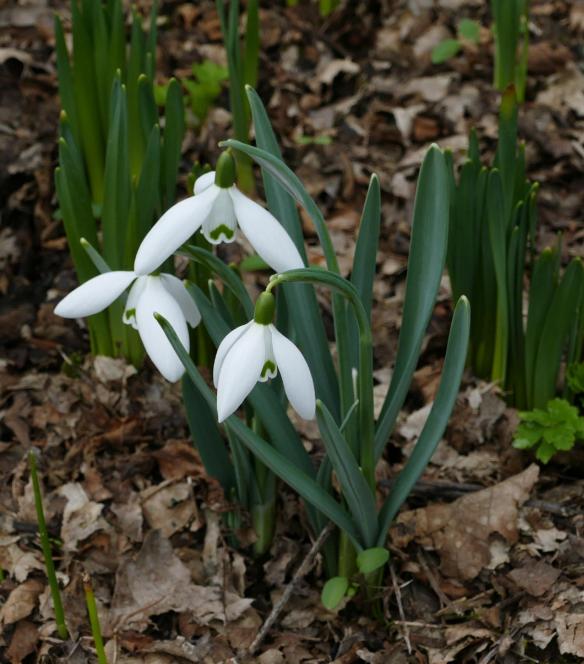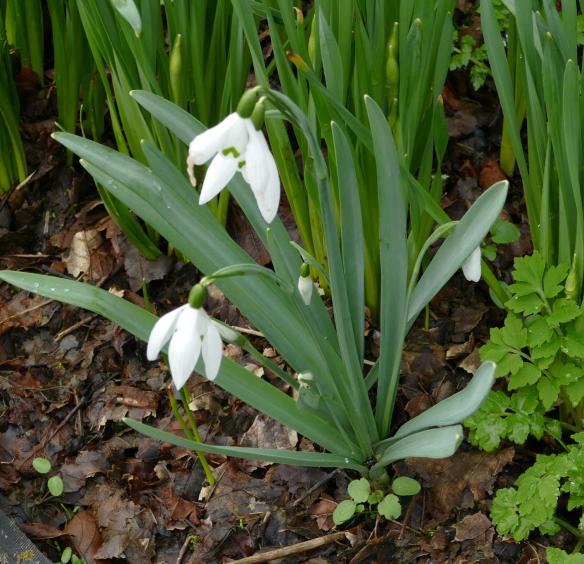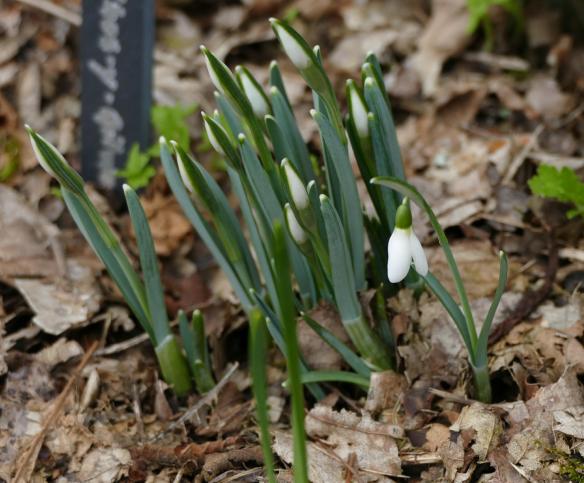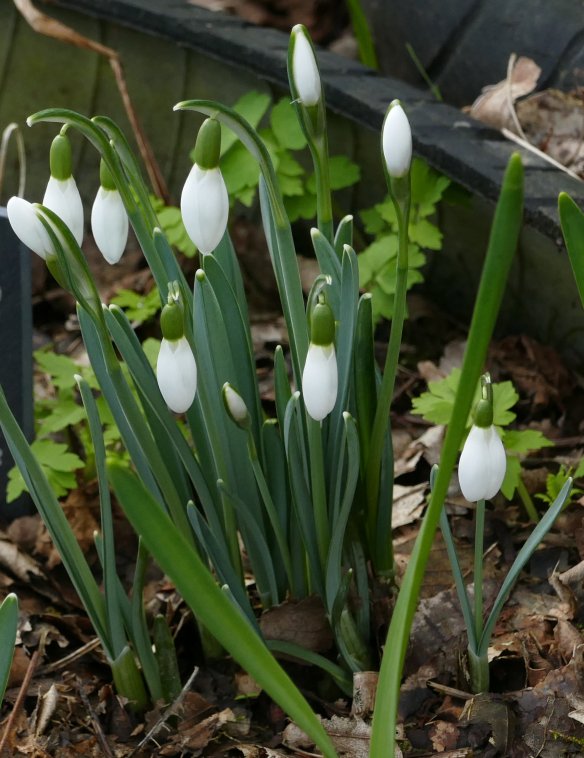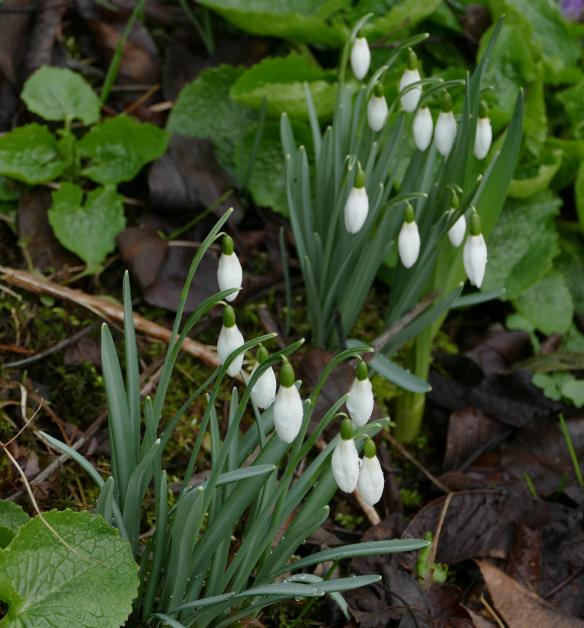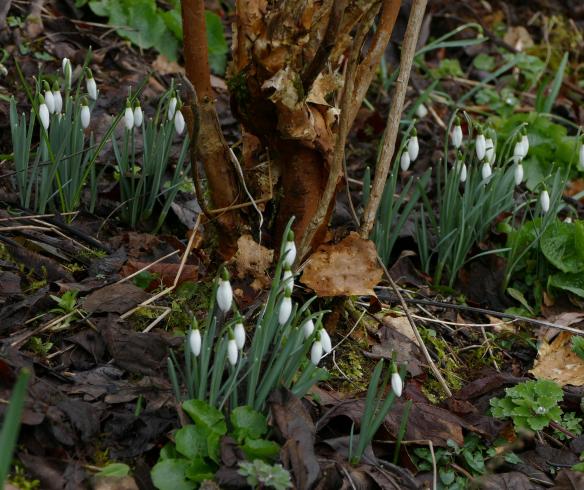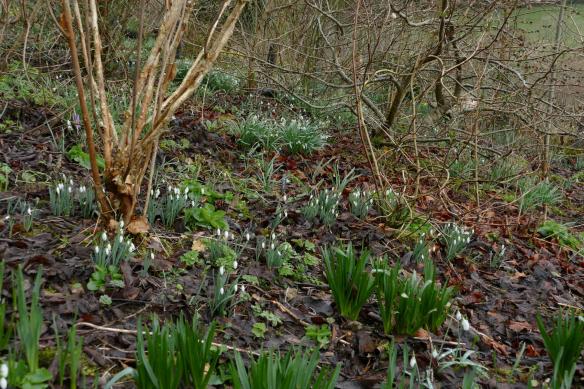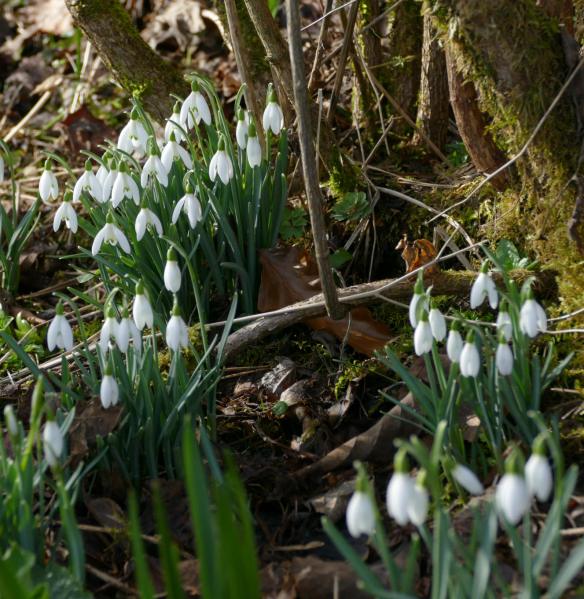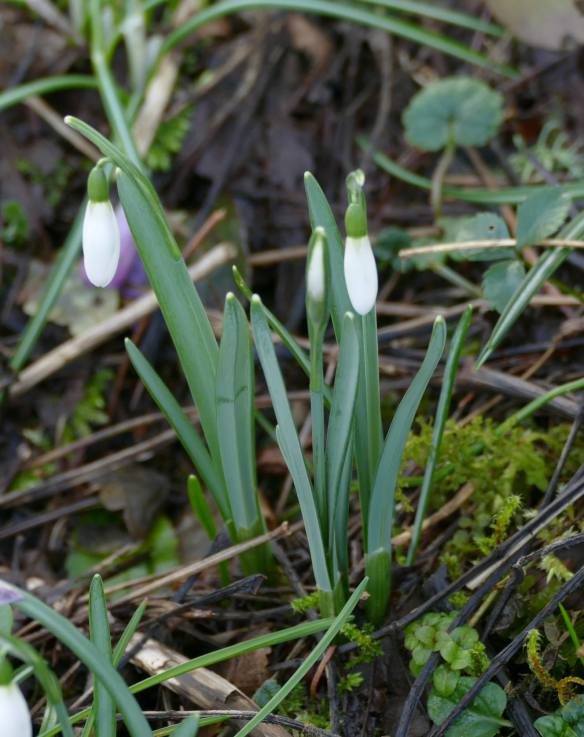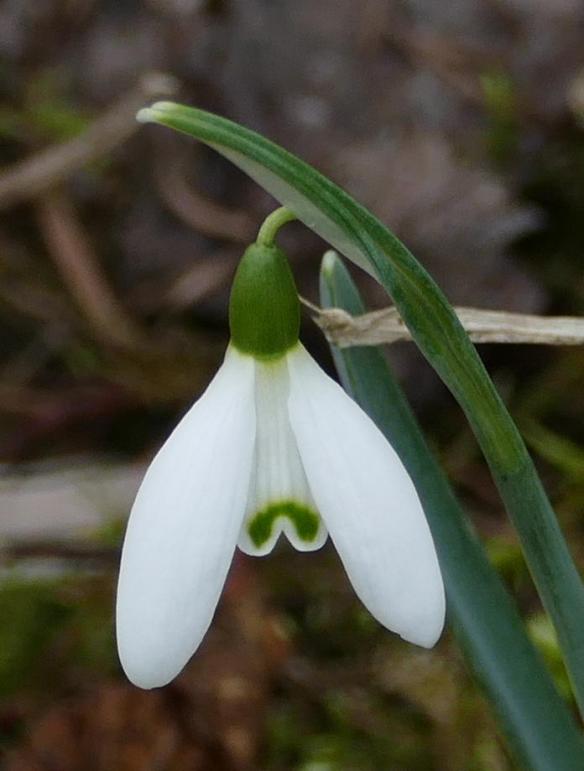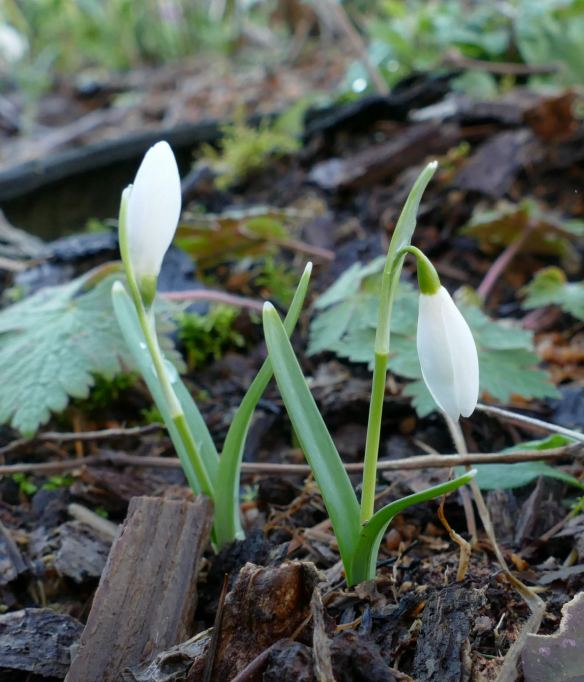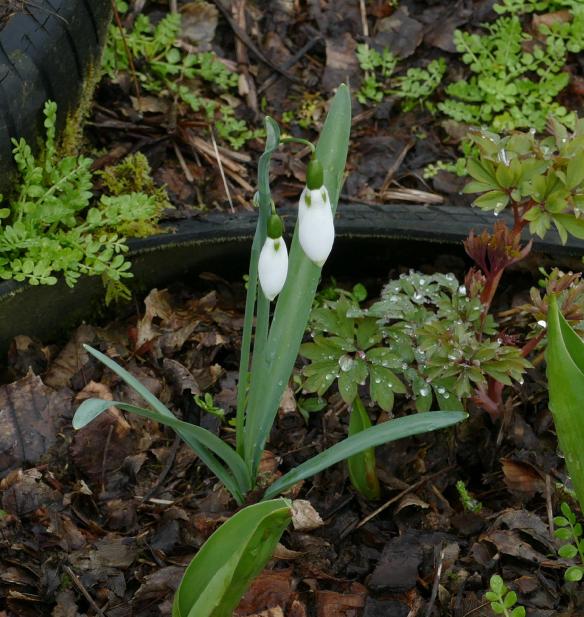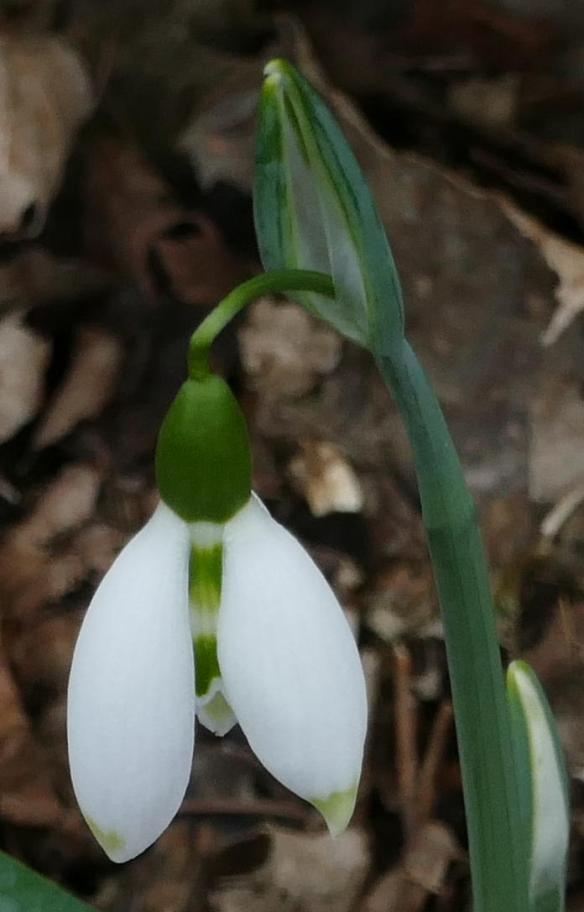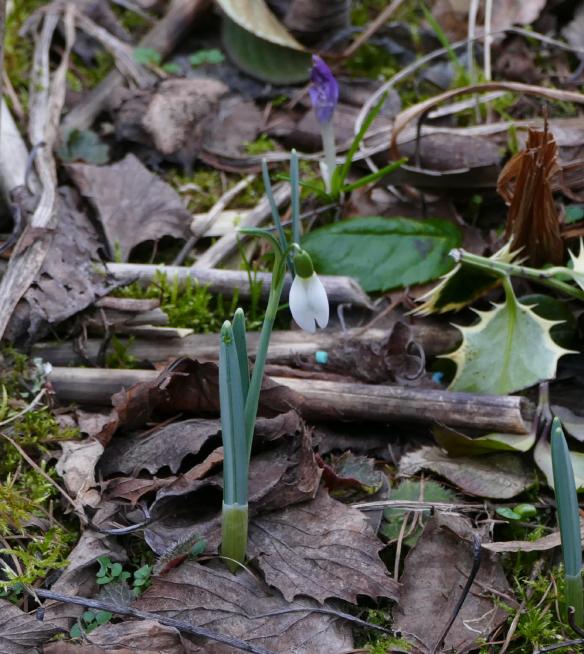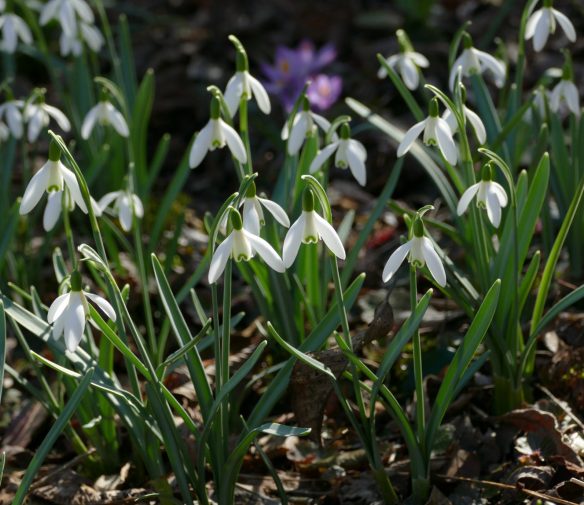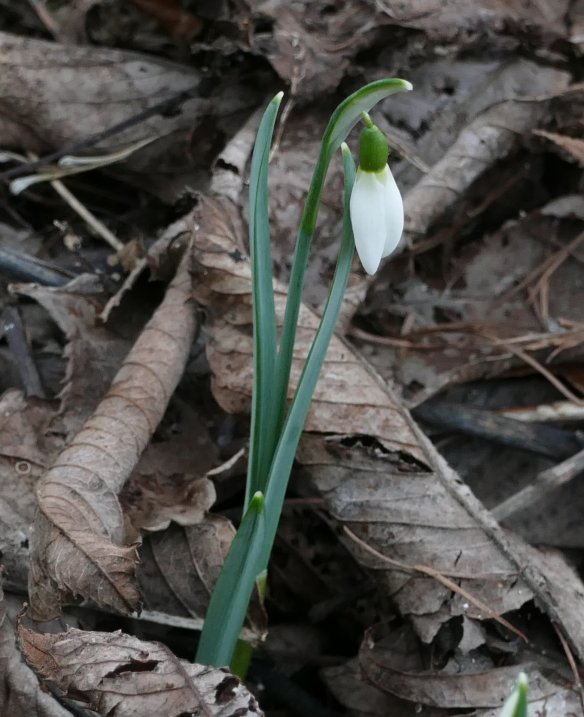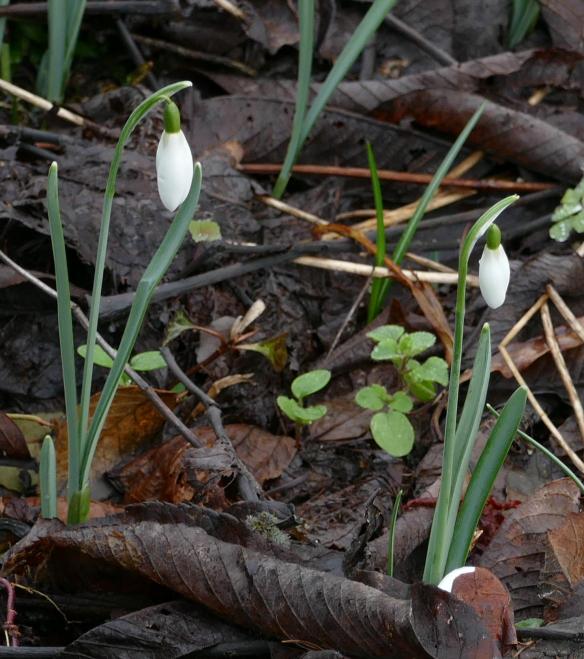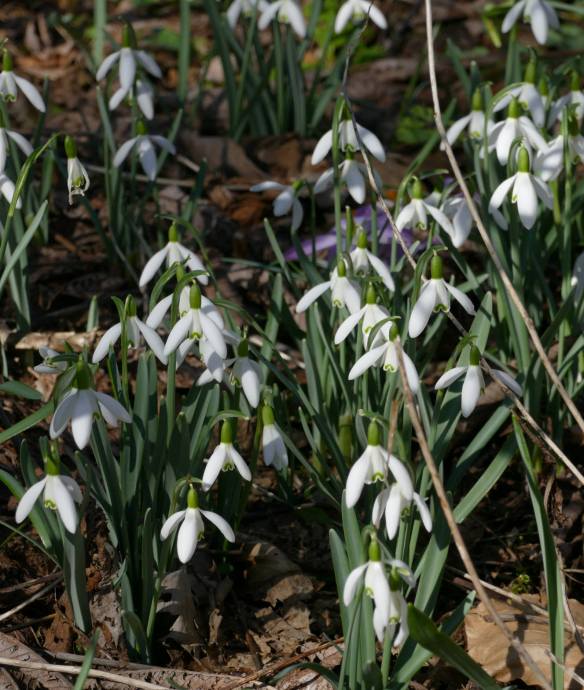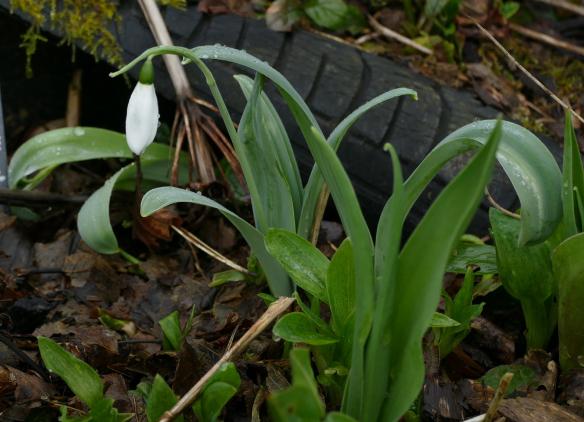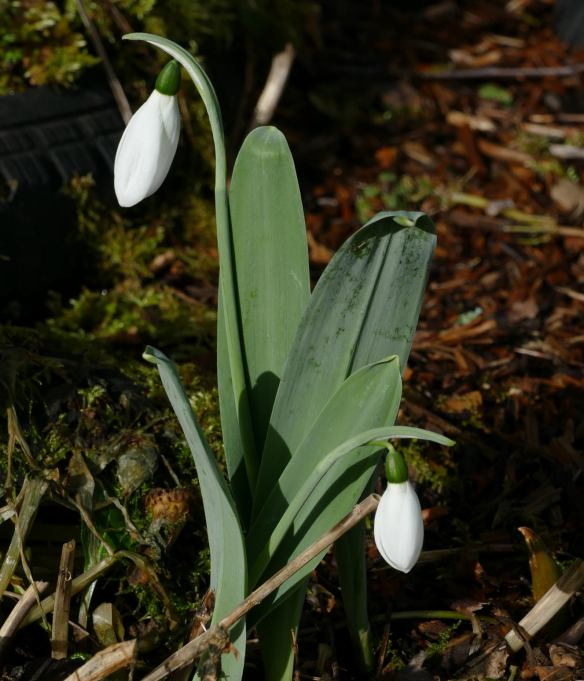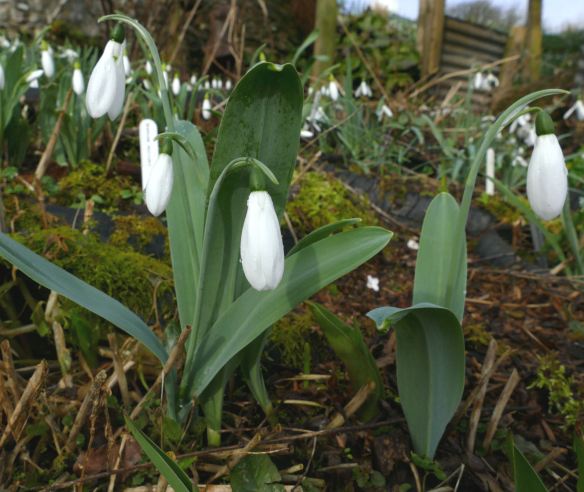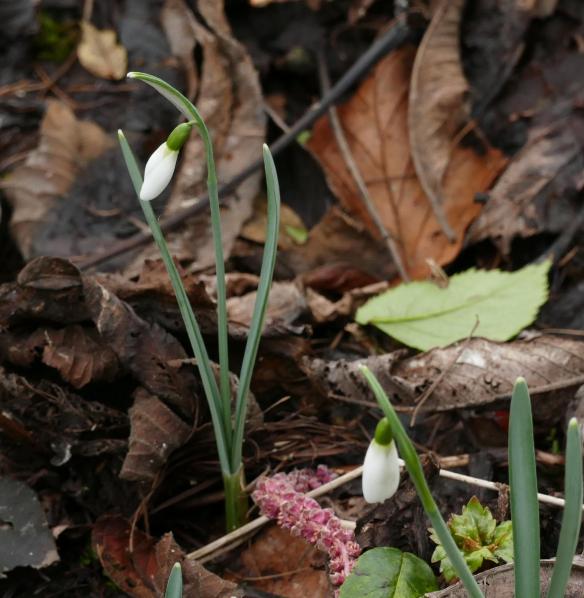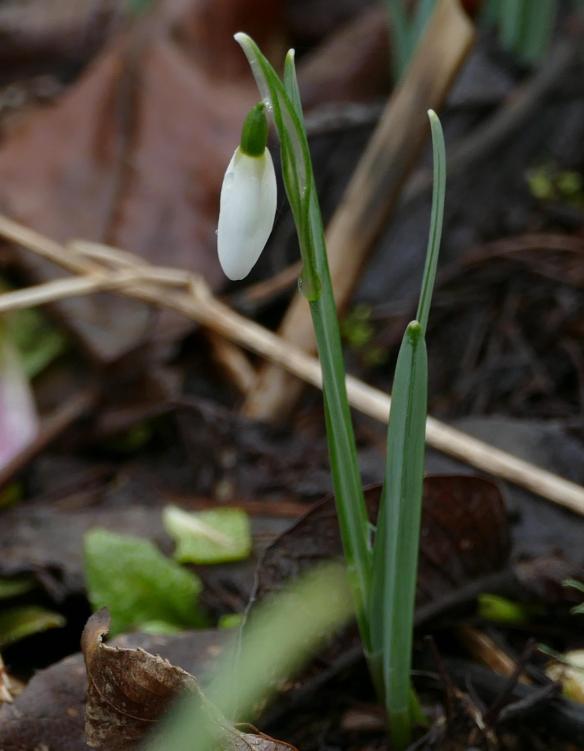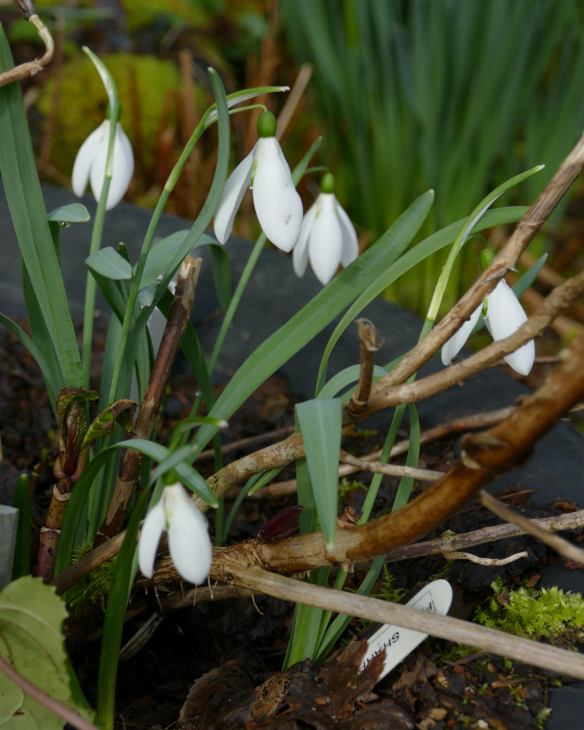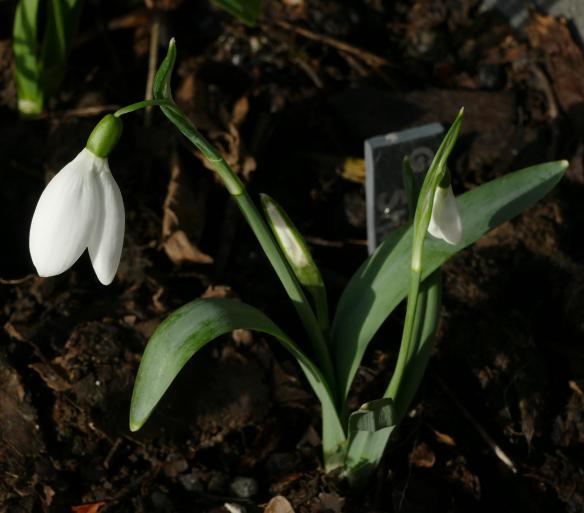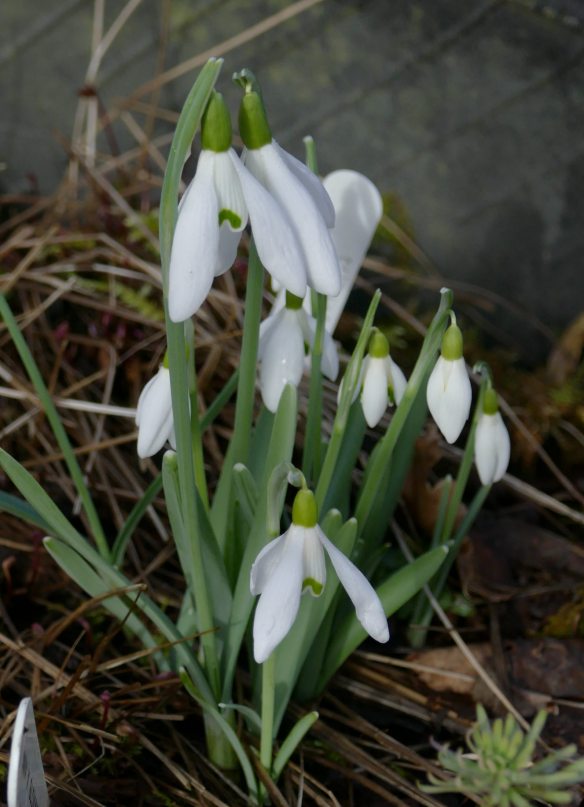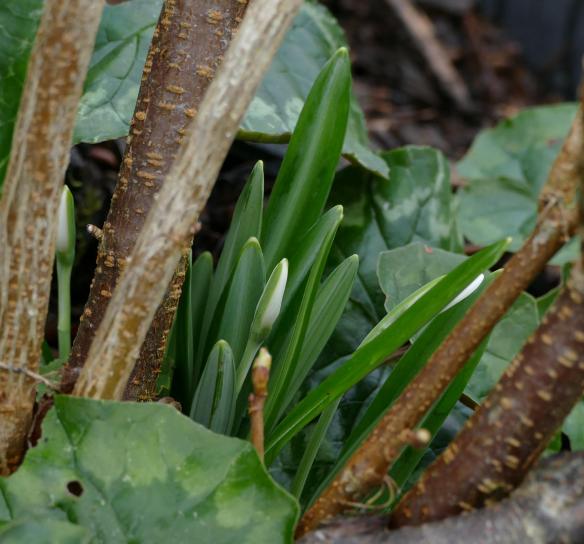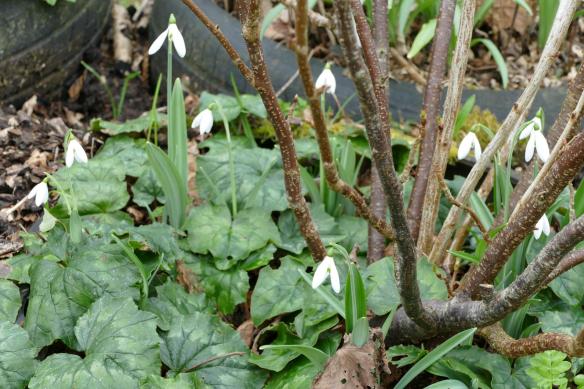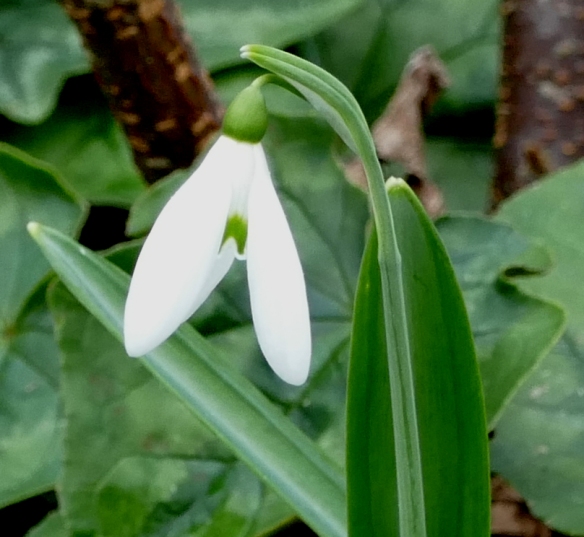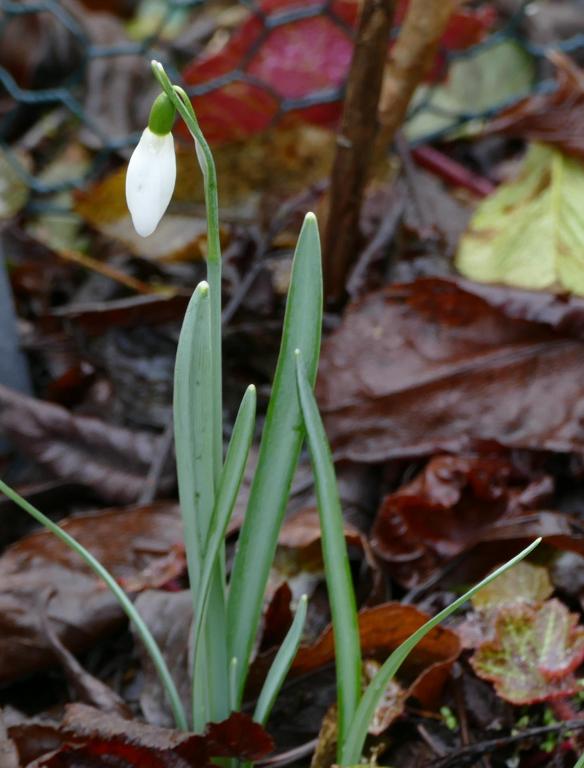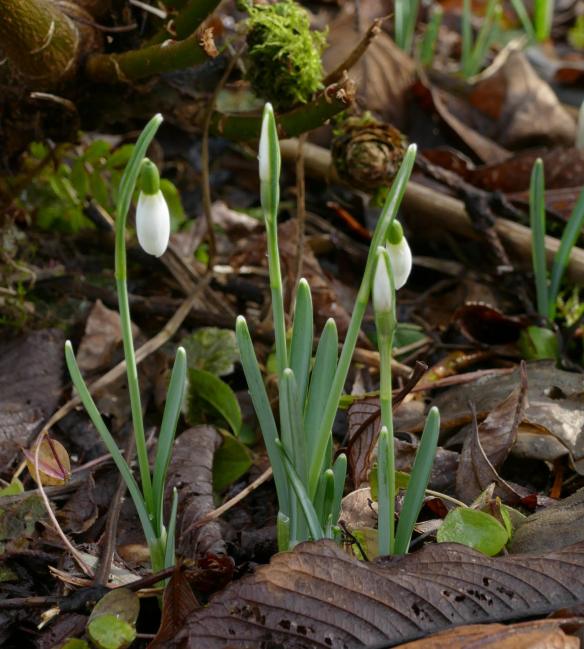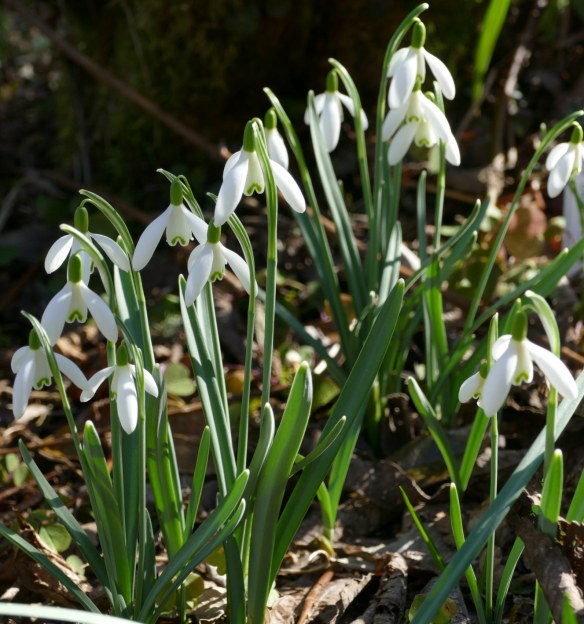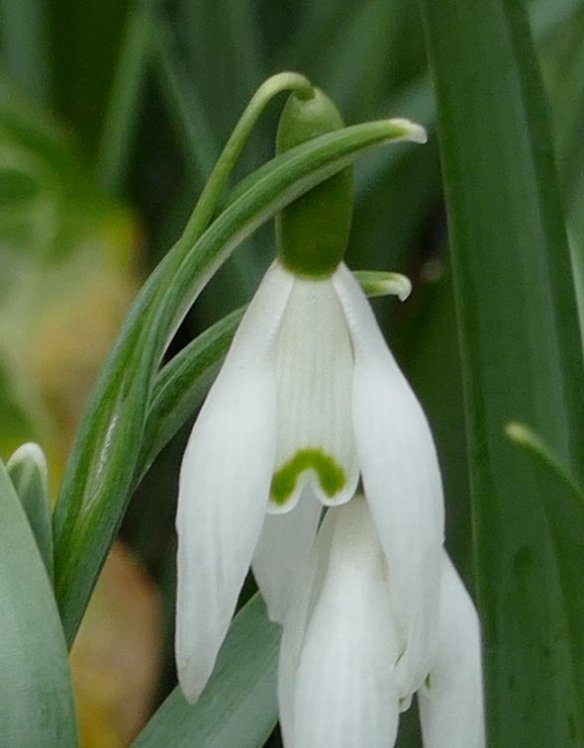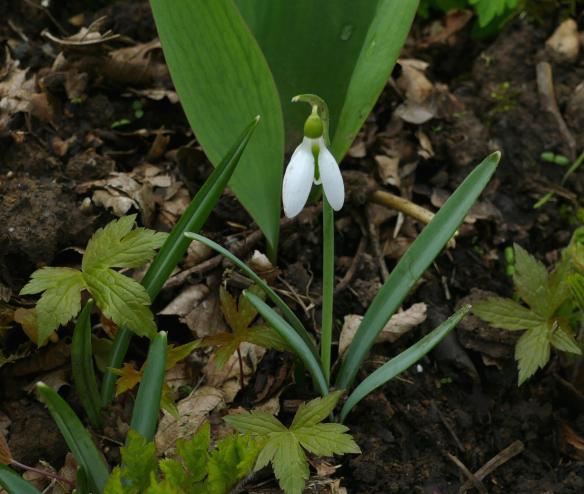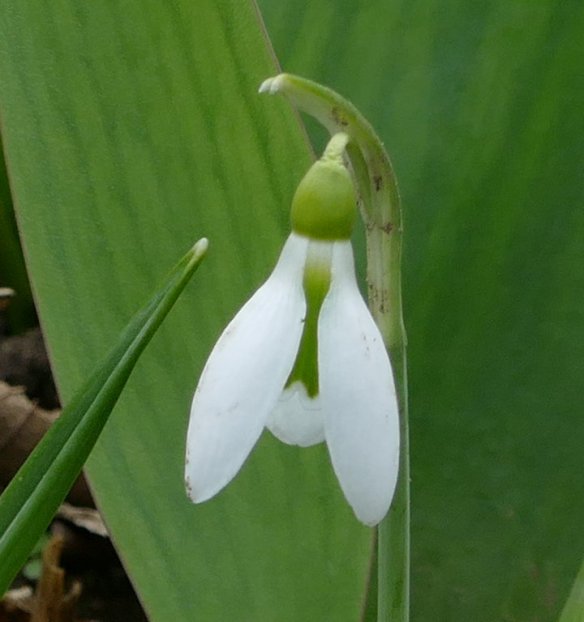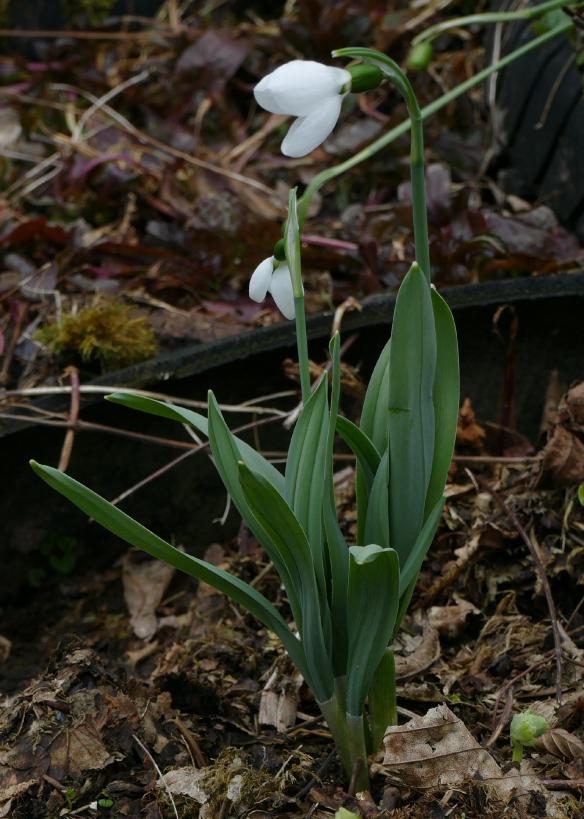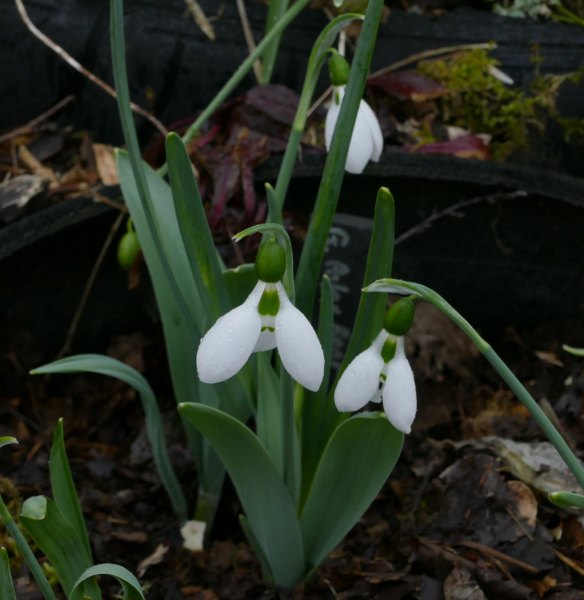This page represents an initial effort at an on-line record of snowdrops (Galanthus species and hybrids) here at Gelli Uchaf. When we acquired the derelict property that is now our home, there was no garden, no flowers save a few old daffodils on our track banks, and certainly no obvious snowdrops for several miles around us. First created just after the first snowdrops emerged in October 2017, this page shadows a huge effort I made during the 2017 snowdrop season to photograph, label and record the majority of the different snowdrops which we then had growing here. It’s been updated a bit since.
We’re currently one of the few NGS gardens in Wales to open as part of their Snowdrop Festival: (Do watch any videos on the HD setting on the cog next to the YouTube logo)
For me, the delight from growing snowdrops comes mainly from having masses of flowers in the garden very early in the year. But knowing which ones are garden worthy and will thrive in our wet conditions has been an evolving challenge, which has gradually led to being able to create vistas like these taken in February 2022 on one of those fairly rare days when the sun shone, without a hard frost!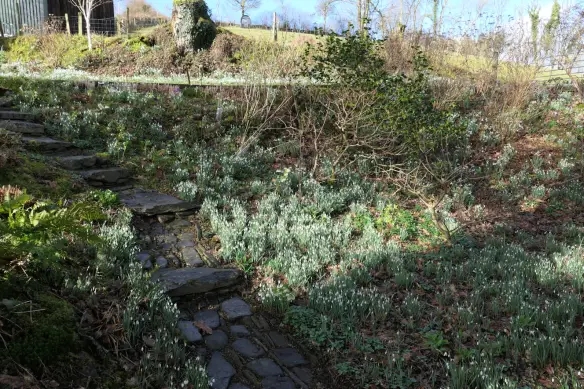



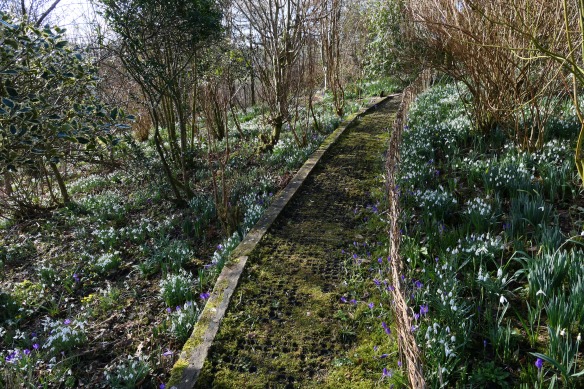

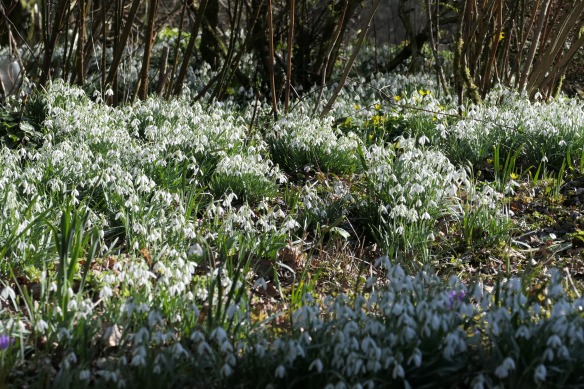

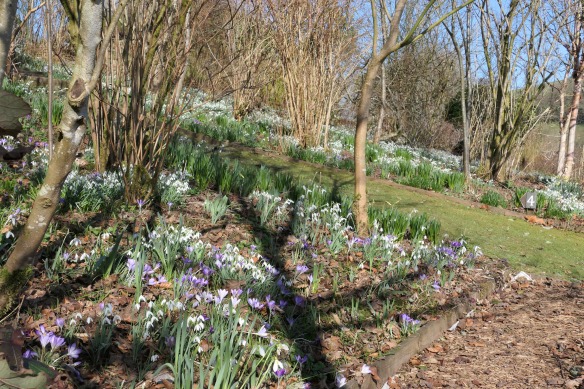

The main reason for this more detailed record of cultivars was that any other sort of simple physical record of these bulbs could easily be lost or damaged. And to be of value to any garden (or blog) visitors, some sort of order and accessible database of photographic images had to be created. Perhaps also for anyone thinking of trying to grow a few different snowdrops for the first time, a little of the reasons behind this simple record might be helpful.
Perhaps it might also help to hint at the appeal of galanthophilia (love or even obsession, with snowdrops) which seems to afflict a small, but growing number of gardeners. The fact that so many frankly only subtly different variants have names associated with the people who found them, or places of origin, links the real appeal of snowdrop sharing – human stories of loved places and the planting of these bulbs to illuminate the scene during the darkest months of the year, when much else outside is dormant or lifeless.
Candles of hope, hinting at the exuberance of spring, a few weeks ahead. And tough enough to cope with whatever winter chucks at them. Googling “thermogenesis in snowdrops” was indeed the cue for me deciding to start a blog of life here, back in early spring 2011, after finding the blog of Carolyn Walker – a confirmed fellow galanthophile and nursery owner in Pennsylvania.
Being quite a novice as far as snowdrops are concerned (say 20 years), I decided a few things were important for these records:
- Many available images of snowdrops show just single photos of the flowers fully open so that you can see the inner segment markings, but often not the rest of the plant. Very appealing to showcase a flower. BUT!!! In many years in our damp upland climate, the occasions when the flowers actually open perfectly like this can be extremely limited. Perhaps just a few hours in total during the season. This is also why getting decent photos of them in situ in the ground is tricky, in poor light. Or wind. Or rain. Or all 3. Last year a camera upgrade with a greater ISO range, helped this project progress.
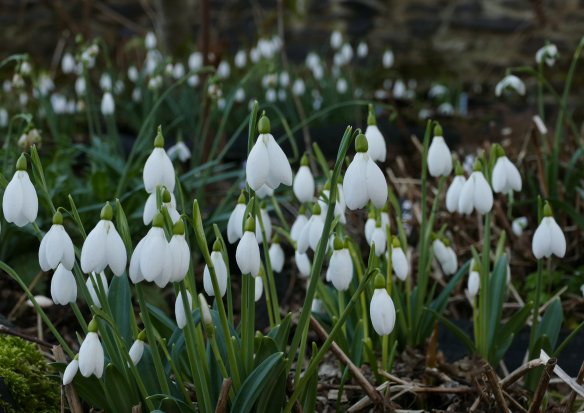 Also, the appeal of these earliest of flowers, for me, is much more tied up with the impact of the whole plant – foliage and flower – in persuading me outside, daily, whatever the weather, through the winter months to see the progress of their appearance. Even sun all day on December 18th 2017, couldn’t persuade many of the flowers of G. ‘Mrs. Macnamara’ to open, below.
Also, the appeal of these earliest of flowers, for me, is much more tied up with the impact of the whole plant – foliage and flower – in persuading me outside, daily, whatever the weather, through the winter months to see the progress of their appearance. Even sun all day on December 18th 2017, couldn’t persuade many of the flowers of G. ‘Mrs. Macnamara’ to open, below.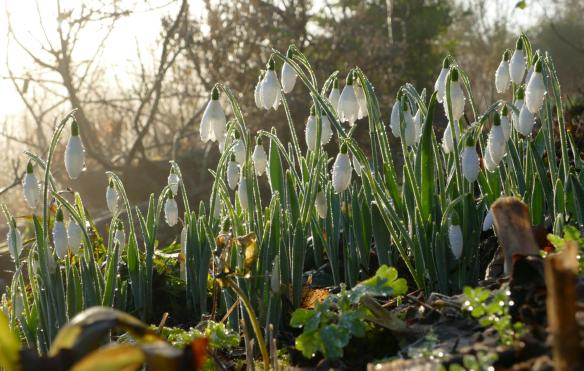 So I’ve tried to illustrate just how this visual impact of the plants changes from when the first flower stem, or “scape”, pushes up through the soil. Inevitably with taking so many photos, some aren’t as good as I’d like, and some varieties don’t yet have a good selection of images available for me to use, in spite of taking nearly 6,000 photos in the 2017 snowdrop season alone.
So I’ve tried to illustrate just how this visual impact of the plants changes from when the first flower stem, or “scape”, pushes up through the soil. Inevitably with taking so many photos, some aren’t as good as I’d like, and some varieties don’t yet have a good selection of images available for me to use, in spite of taking nearly 6,000 photos in the 2017 snowdrop season alone.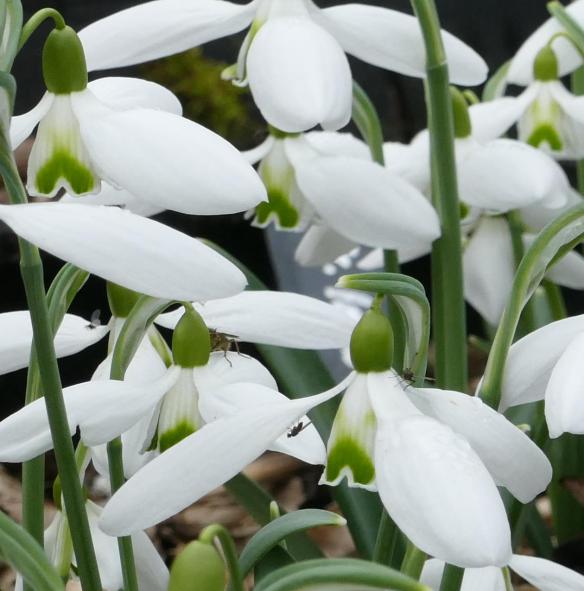
- For similar reasons, when the flowers first appear is very important to me. Which is why I’ve listed them not alphabetically, but in order of appearance (beginning in 2017). Having recorded opening sequences for a few years now, there seems to be a remarkably good correlation for most varieties, relative to other cultivars, from one year to the next, give or take a few days – even with weather differences. Also as of 2020, there’s clear evidence that left undisturbed, many forms’ flowering times creep a little earlier each year – possibly because replacement bulbs tend to end up nearer the soil surface. If you want to plan for a long season of snowdrops within a garden, having a good idea of relative flower opening times is very important.
 Though even within a single garden, considerable variation in flower opening times will be the result of subtle micro-climate differences, and other factors around the garden. If you want to search these records more quickly for a particular snowdrop, you can just type in the name in the search box at the top right of this page, above the header photo.
Though even within a single garden, considerable variation in flower opening times will be the result of subtle micro-climate differences, and other factors around the garden. If you want to search these records more quickly for a particular snowdrop, you can just type in the name in the search box at the top right of this page, above the header photo.
- My definition of first flower “opening” (shown in bold italics in the description) in these lists relates to the point at which the first flower bud of a variety emerges from the spathe (the spear like sheath which protects the flower as it is forced up through the earth), and begins to turn towards horizontal. This is really when the snowdrop flowers start to have an impact on the scene (from a human perspective). And this change from vertical to horizontal nearly always happens very quickly, in less than 24 hours, and often overnight provided ambient temperatures are high enough.
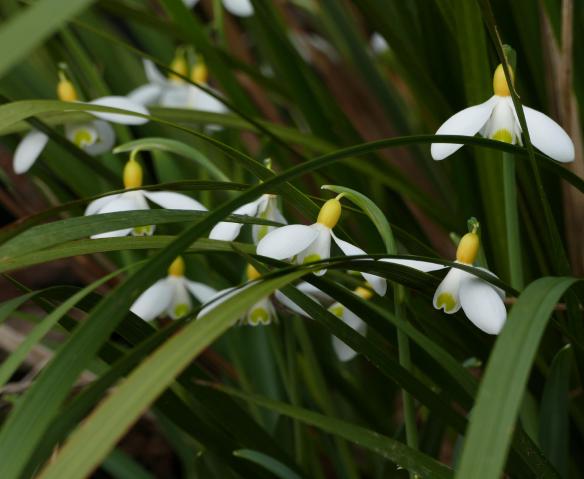
- I might add more detail on leaf and flower form with time, since such minutiae of detail do help with cultivar identification, but to people with no knowledge of this terminology, I think it would just make things more complicated for this sort of simple guide. (How often do the snowdrops look like those below, with outer segments spread wide? Not very often here in 2017, or 2018).

- Gradually, I shall highlight those varieties that seem particularly garden worthy, at least in our garden. As with all groups of plants, nurseries rarely record this very important detail, but how vigorous or floriferous a variety turns out to be in our conditions, is what I’m interested in. Not simply how unusual a flower is. Since it’s when snowdrops flower en-masse, that they really wow me.
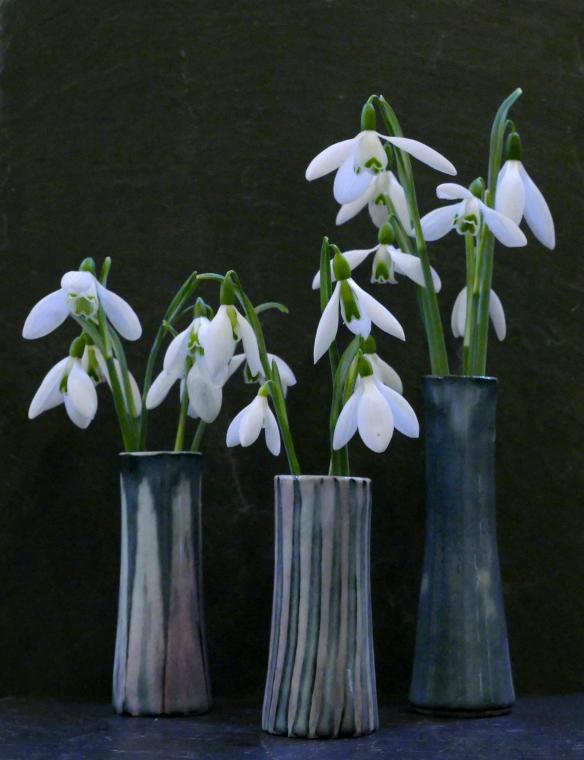 To be fair to the nurseries, although some older named cultivars may have good anecdotal information on vigour, the rush to get the latest new form onto the market for serious galanthophiles, (probably by very carefully slicing or “twin-scaling” the bulbs to bulk them up more quickly), means that this feedback from gardeners on how they perform in the ground may simply not be available. Perhaps another very good reason for any budding galanthophile to avoid the latest, most expensive offerings?
To be fair to the nurseries, although some older named cultivars may have good anecdotal information on vigour, the rush to get the latest new form onto the market for serious galanthophiles, (probably by very carefully slicing or “twin-scaling” the bulbs to bulk them up more quickly), means that this feedback from gardeners on how they perform in the ground may simply not be available. Perhaps another very good reason for any budding galanthophile to avoid the latest, most expensive offerings? 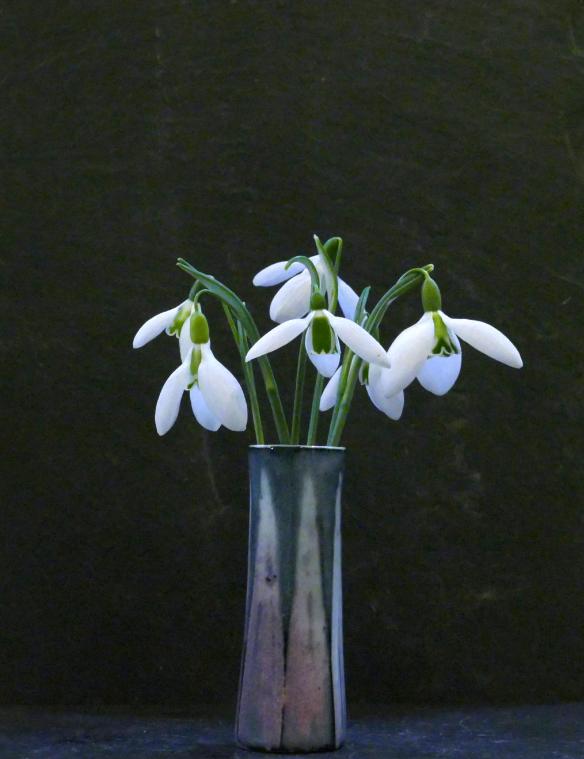 Sadly, a significant proportion of the named snowdrops which I’ve tried to grow, take so long to bulk up here that I don’t think they fall into this critical garden worthy category. Like G. elwesii ‘Peter Gatehouse’ below, at least in our garden:
Sadly, a significant proportion of the named snowdrops which I’ve tried to grow, take so long to bulk up here that I don’t think they fall into this critical garden worthy category. Like G. elwesii ‘Peter Gatehouse’ below, at least in our garden:

- Some snowdrops remain unnamed or unidentified in these lists and increasingly there will be several with the WHSH prefix, which indicates that they are part of my Welsh Historic Snowdrop Hunt project. For more information on the ideas behind my WHSH project, please click here. I’m extremely grateful to all the wonderful people who have allowed me to visit, photograph and collect sample bulbs, and also given me the fascinating human stories that usually accompany “old” snowdrop sites. Most of these varieties do indeed fall into the garden worthy category – at least for this wetter part of the world.

- Anyone looking for expensive rarities or the latest named cultivars in this list will be disappointed. I have a very modest upper maximum price for buying a snowdrop bulb – not much more than a nice bottle of wine (and I don’t drink anyway). It really is more important for me to have reliable good doers which create an extended season of interest, and anyway, if a new variety is expensive and a good doer, then quite quickly it will become more affordable. The wonders of time and biological multiplication, (generally following the Fibonacci sequence), working well without any recourse here to the artificial “twin-scaling” of bulbs for propagation, which I’ve never had the time or enthusiasm to carry out. Yet.
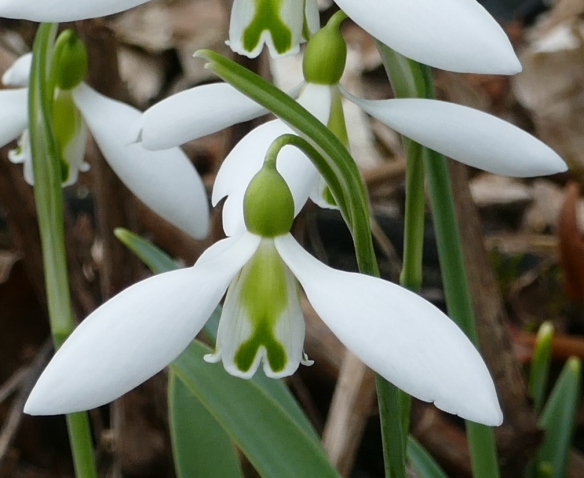
- To make these records more manageable, I’ve somewhat arbitrarily grouped the different cultivars, or forms, into 3 seasons, and this initial list runs from the very early flowering types, sometimes in October, to the middle of January based on when the first flowers appear. To illustrate the fact that snowdrops are really very variable in height, flowering time, markings and form, all the flowers below are different varieties which were in bloom here on New Year’s day 2018, when many would think the snowdrop season hadn’t even begun.

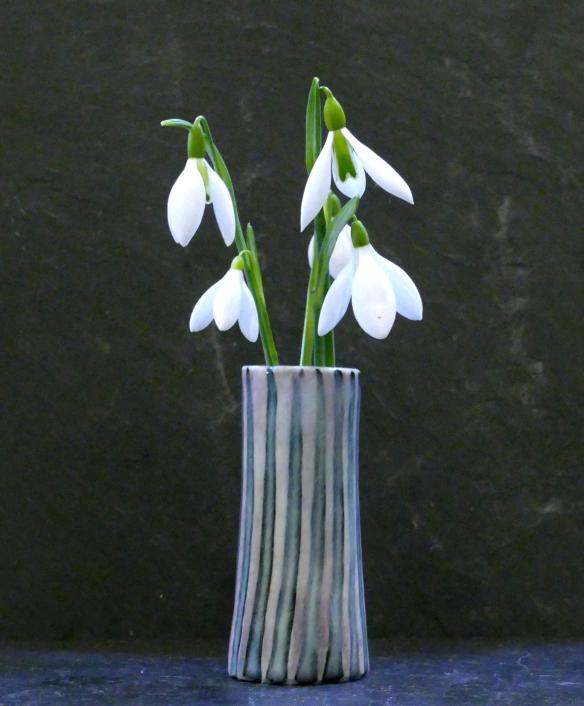
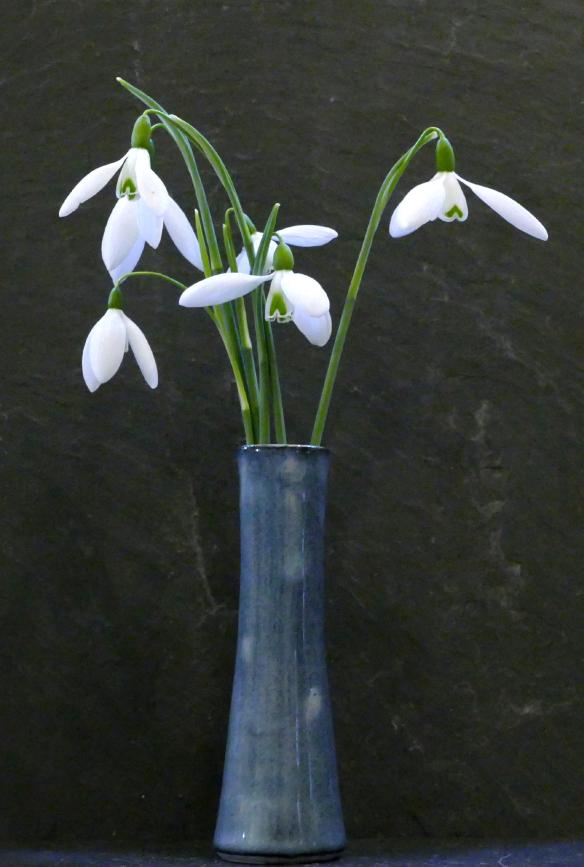 Typically an early season individual flower will last for up to 6 or 7 weeks, but as a clump becomes larger, the spread of flowering times means at least a good 2 or even 3 months of flower interest is possible from a single cultivar.
Typically an early season individual flower will last for up to 6 or 7 weeks, but as a clump becomes larger, the spread of flowering times means at least a good 2 or even 3 months of flower interest is possible from a single cultivar.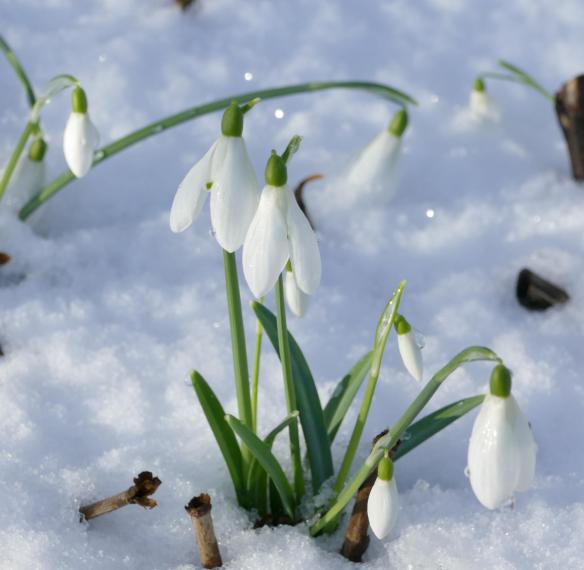 Different bulbs at deeper locations in a clump will tend to flower later, and some cultivars frequently produce 2 flowers per bulb, at different times, which obviously extends the flowering season. Later flowering forms don’t tend to last in flower for as long, since temperatures are likely to be higher, and thus the flowers grow and mature faster, and the flowers are also more likely to be pollinated in warmer weather, with potential pollinators around. Such pollination obviously then brings their flowering to a fairly speedy close.
Different bulbs at deeper locations in a clump will tend to flower later, and some cultivars frequently produce 2 flowers per bulb, at different times, which obviously extends the flowering season. Later flowering forms don’t tend to last in flower for as long, since temperatures are likely to be higher, and thus the flowers grow and mature faster, and the flowers are also more likely to be pollinated in warmer weather, with potential pollinators around. Such pollination obviously then brings their flowering to a fairly speedy close. 
- For those intrigued by some of the photo backgrounds, many of the named cultivars are growing in the retyred matrix part of our garden. There are also over a million bulbs (I would estimate) elsewhere in the garden growing in a more natural setting.
 The tyres have proved to be an ideal setting for keeping named individual cultivars separate and easily labelled, and providing the moist but free draining conditions during active growth, as well as the shade and generally drier conditions through the summer months, which most snowdrops prefer. In nearly all the examples growing here, the snowdrops are succeeded by perennial plants, mostly chosen for their potential appeal as good nectar or pollen sources, for our diverse native insect population, later in the year.
The tyres have proved to be an ideal setting for keeping named individual cultivars separate and easily labelled, and providing the moist but free draining conditions during active growth, as well as the shade and generally drier conditions through the summer months, which most snowdrops prefer. In nearly all the examples growing here, the snowdrops are succeeded by perennial plants, mostly chosen for their potential appeal as good nectar or pollen sources, for our diverse native insect population, later in the year.
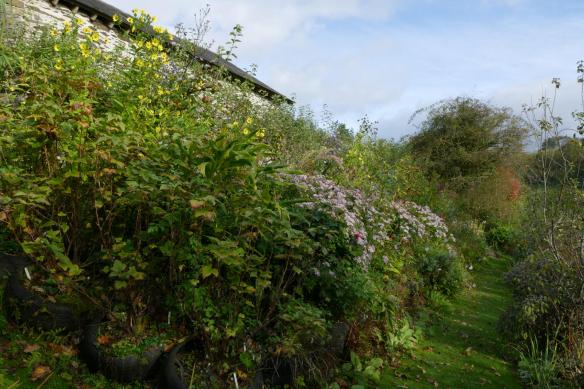

- The bulbs growing in the tyres receive a couple of scatterings of wood ash from our stoves during the year, a single scattering of seaweed meal in early winter, and get mulched with homemade, twice chopped (with our lawnmower to aid decomposition) leaf mould, as soon as possible after cutting back the other herbaceous perennials, in about late October or early November.
 This is around the time that the early season snowdrop shoots are nosing through the ground. In the rest of the garden the snowdrops get similar treatment, but just natural leaf fall, with no mulch. Fallen leaves are never removed from most of the garden, just the paths.
This is around the time that the early season snowdrop shoots are nosing through the ground. In the rest of the garden the snowdrops get similar treatment, but just natural leaf fall, with no mulch. Fallen leaves are never removed from most of the garden, just the paths.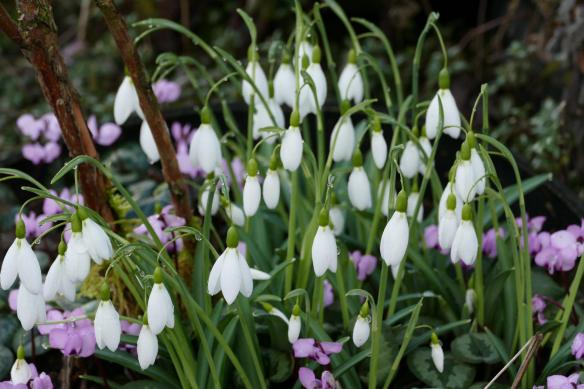
- Currently, named varieties are lifted and split about every 3 to 4 years within the tyres, once there are a few flowers per cluster, with the aim of eventually creating a bolder impression of what the varieties can look like en masse. Though like many gardening plans, one needs a patient approach towards this goal. Some cultivars are so slow to bulk up that this effect will probably never be seen. At least by me. This lifting and moving can only be done in winter or early spring, since the perennial plants prevent access during the bulb’s dormant period. Though as from 2019, I aim to complete this even earlier – from early December onwards, as soon as the cultivar’s bulb shoots begin to nose through. I’m convinced this stresses the plants less, since they have well developed roots, but minimal foliage to support.
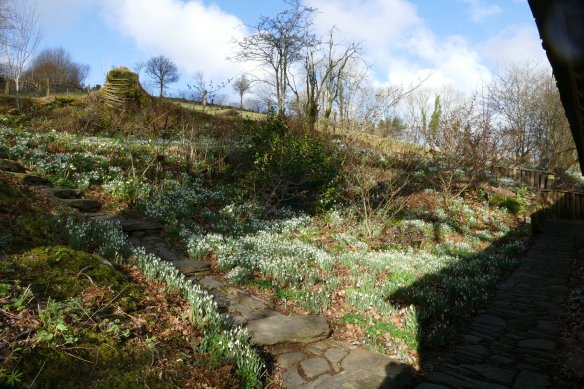 Many snowdrop experts would say bulbs should only be moved when dormant, in summer, but provided I do it during a period of damp or wet weather, with minimal root disturbance, I only get a minor drop off in flowering the following year. However we are “blessed” here with a typical range of 1700 to 2100 mm of annual rainfall, which is much higher than many parts of the UK, and increasing over the winter months, in recent years. (G. ‘Grumpy’, below).
Many snowdrop experts would say bulbs should only be moved when dormant, in summer, but provided I do it during a period of damp or wet weather, with minimal root disturbance, I only get a minor drop off in flowering the following year. However we are “blessed” here with a typical range of 1700 to 2100 mm of annual rainfall, which is much higher than many parts of the UK, and increasing over the winter months, in recent years. (G. ‘Grumpy’, below).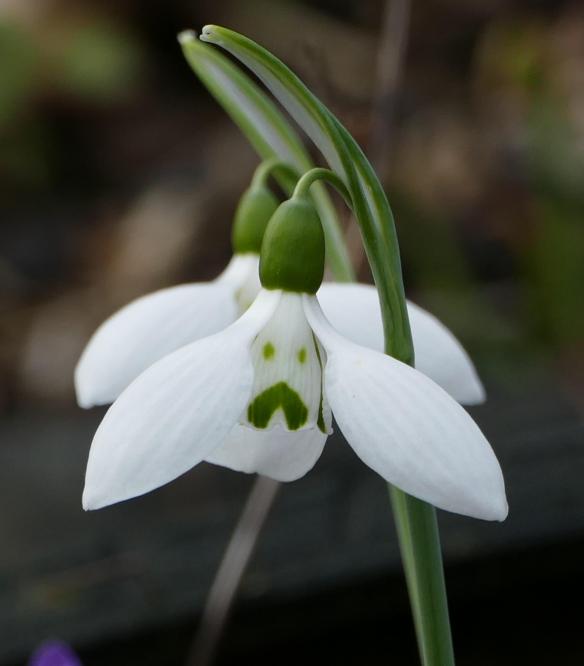
(Our snowdrop silk scarf design above – see separate web page for more details).
LATE SEASON
(Since I started this online record, the majority of snowdrops have begun to flower earlier in most years. As a consequence, in 2020, I’ve shifted several cultivars into earlier sections, and with this late group, am going to change the date of first flower to the beginning of February, rather than the middle, to reflect these changes in phenology, probably linked to climate change. It will also make each season a little more equal in numbers. I tend not to be so interested in later flowering snowdrops, since they inevitably don’t last for as long, and heading into March, there are other exciting things happening in the garden!
(The 2022 season has reversed this trend for earlier flowering, in part I think because of the generally mild autumn and winter, and lack of sunlight from late autumn onwards. I’m going to stop updating this page from 2022, since with nearly 350 varieties, it becomes a tedious task. Other than to say the current 2023 season was another slow-one to begin.)
February to early March
G. elwesii ‘Galadriel’. Acq. 2012. A seedling form from Beth Chatto’s garden, with typical broad elwesii foliage and a very distinctive large flower with Y shaped inner segment marking. A favourite, vigorous, beautiful snowdrop. (February 22nd 2017, February 8th 2018, February 6th 2019, January 31st 2020 – 232nd to flower, February 6th 2022 – 238th to flower).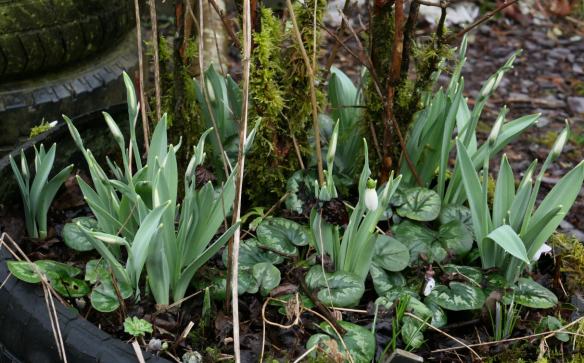
______________________________
G. ‘Trymlet’. Acq. 2018. A typical pagoda shaped ‘Trym’ like seedling with inverted green hearts on the outer segment tips. Vigorous here. (February 9th 2019, January 31st 2020 – 221st to flower, January 28th 2022 – 154th to flower.)

G. nivalis WHSH ex LS ABGL 1. Acq. 2018. A quite tall, slender, local form. (February 9th 2019, February 2nd 2020 – 243rd to flower, February 3rd 2022 – 224th to flower.)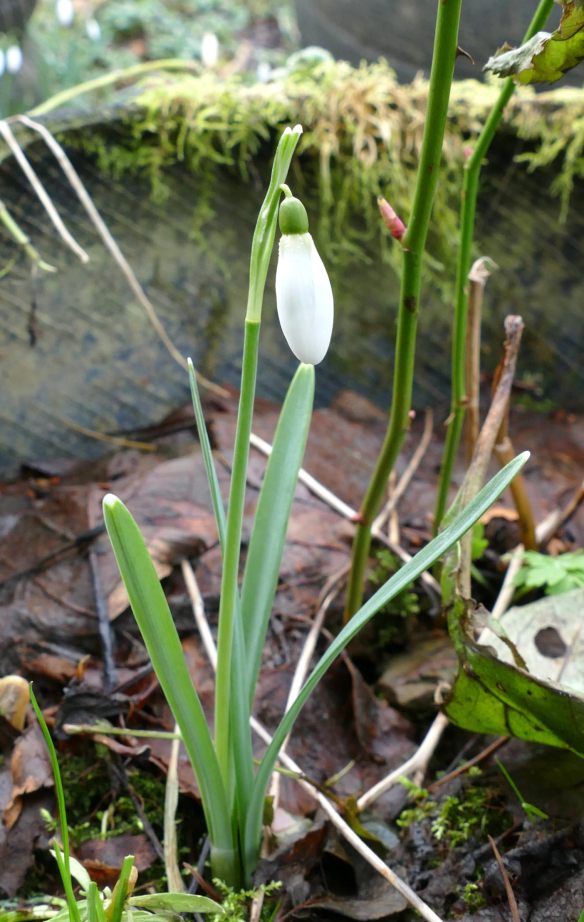
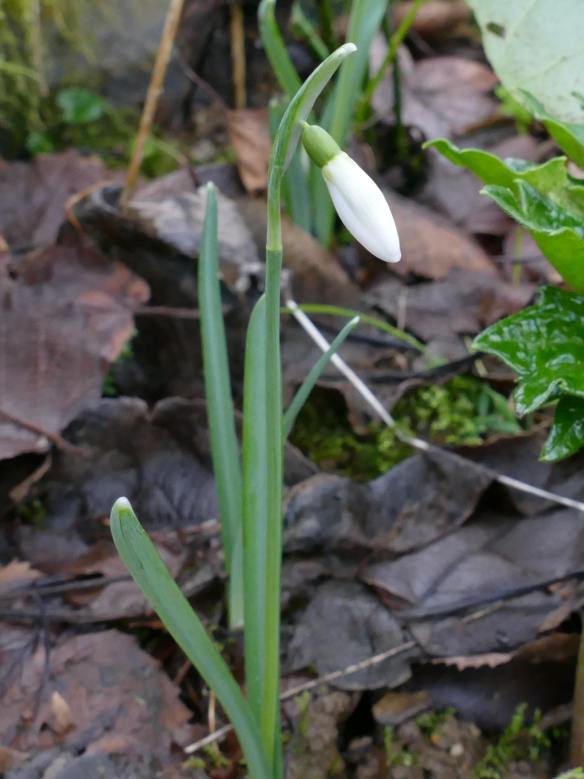
G. ‘Curly’. Acq. 2012. A vigorous, smaller, single late flowered hybrid with faint green tips to the outer segments. The end third of the leaves splay out in a characteristic bent way as they develop. (February 15th 2017, February 8th 2018 – split, January 27th 2019 – split, February 3rd 2020 – 246th to flower)
_______________________
G. nivalis WHSH EID LGN 2. Acq. 2017. A later form from this old cottage. (February 1st 2020 – 236th to flower) 
______
G. ‘Cliff Curtis’. Acq. 2017. (January 26th 2018, February 4th 2019, January 31st 2020 – 228th to flower) 
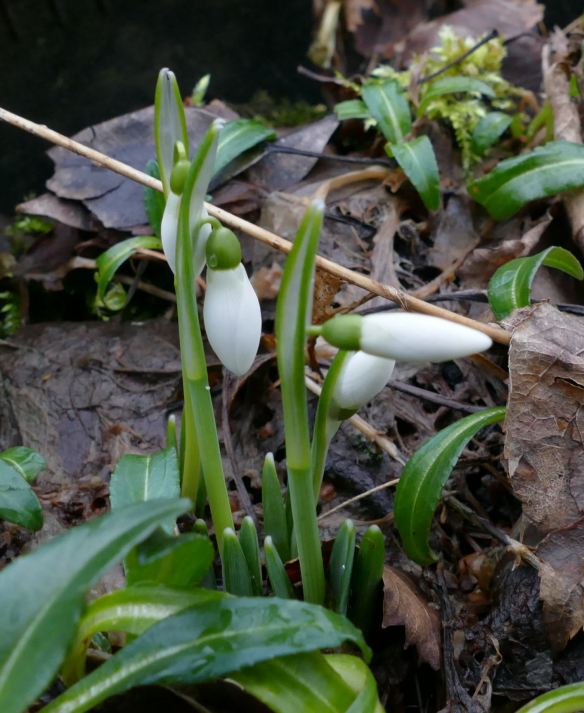

_____________________
G. elwesii ‘David Shackleton’. Acq. 2012. A clone of the species with the basal mark entire and paler than the apical mark.(February 2nd 2017, January 27th 2018 – split, February 4th 2019, February 3rd 2020 – 244th to flower)
___________
G. plicatus ‘Warham Rectory’. Acq. 2012. A named form of the species, but probably the same as the more commonly described G. ‘Washfield Warham’, which is listed at the end of the Mid Season snowdrop list. This dates back to about 1916 when a fine late flowering G. plicatus was spotted and sent by Revd. Digby of Warham, Norfolk to E. A. Bowles, the eminent bulb expert. In fact it’s thought that it was brought back to the village originally by a Captain Adlington on his return from the Crimean War. (February 16th 2017, January 6th 2022 – 232nd to flower) .
________________________
G. ‘Midge’. Acq. 2016. A late, single flowered hybrid with very short leaves. (February 18th 2017, 2018-NF, 2019-NF, February 8th 2020 – 252nd to flower, January 29th 2022 – 166th to flower).
_______________________
G. nivalis WHSH K CT TL. Acq. 2015. A local, late form of the native species, with a long ovary. (February 18th 2017, February 17th 2018, 2019 – NA, February 7th 2020 – 248th to flower).
G. nivalis 1 ex Slovenia. Acq. 2019. A low growing, later form. (February 16th 2020 – 273rd to flower, February 6th 2022 – 240th to flower).
___________
G. ‘St. Anne’s’. Acq. 2016. A single flowered hybrid, elegant long narrow snowdrop, not very vigorous. (February 18th 2017, February 17th 2018, 2019 NA, February 16th 2020 – 269th to flower).
____________________________
G. Seedling of John Long. Acq. 2017. February 18th 2017 to mid March. A single flowered hybrid with an unusually kinked pedicel, just before attachment to the ovary. Will this be a consistent feature?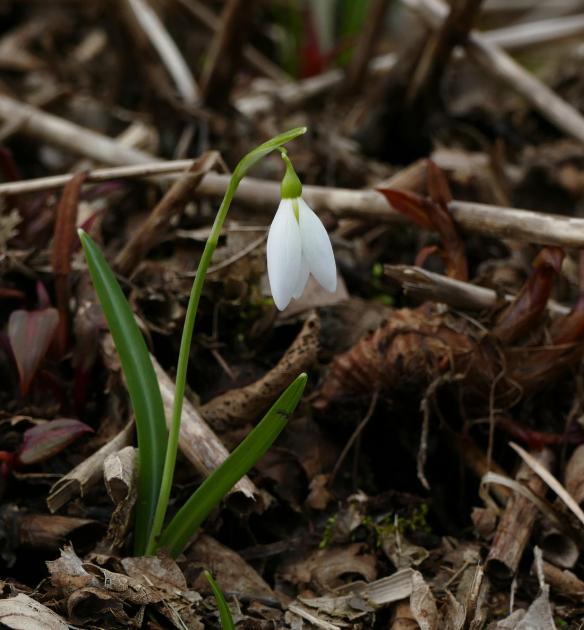
________________________
G. ‘Straffan’ SP4. Acq. 2010. An elegant, single, later flowering hybrid. I think that is G. ‘Straffan’, which we acquired years ago, before we kept good records! It is a late flowerer and typically produces a second flower scape, as you can see from the second photo, which extends the flowering season. (February 18th 2017 – 190th to flower, February 2nd 2022 – 219th to flower).
___________________________
G. nivalis WHSH T CL H LYBD. Acq. 2014. A tall, vigorous, late flowering local form of the species. ( February 18th 2017, February 17th 2018, February 12th 2019, February 7th 2020 – 249th to flower.)
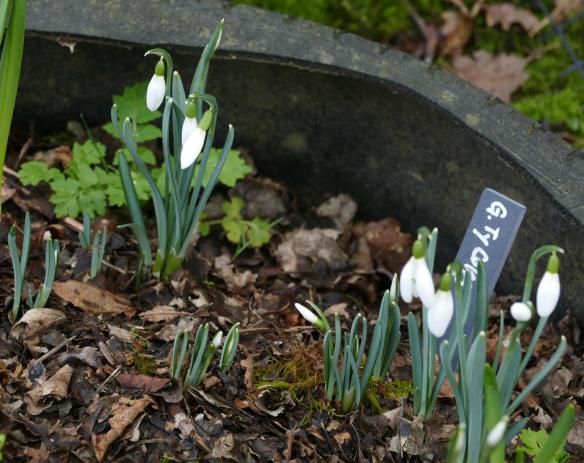
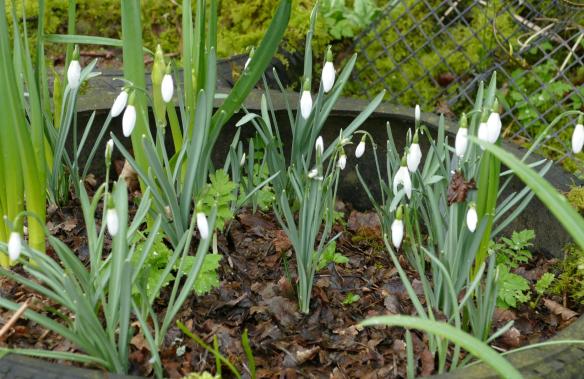

G. nivalis WHSH RYGW 2 . Acq. 2015. A local form of the native species. (February 18th 2017, February 17th 2018, February 15th 2019, February 16th 2020 – 270th to flower).
__________________________
G. nivalis WHSH DG M PCR. Acq. 2014. A locally sourced, late flowering form of the native species. (February 18th 2017, February 8th 2018, February 7th 2019)
G. nivalis WHSH CP CM 2. Acq. 2016. A local later form of the native species. (February 18th 2017, February 17th 2018, February 13th 2019 – 294th to flower, February 16th 2020 – 282 nd to flower.)
G. nivalis WHSH BS PL W 1. Acq 2019. An earlier flowering form of bulbs sent from Wells, Somerset from a site with possible links to a site in West Wales. (February 16th 2020 – 275th to flower.) 
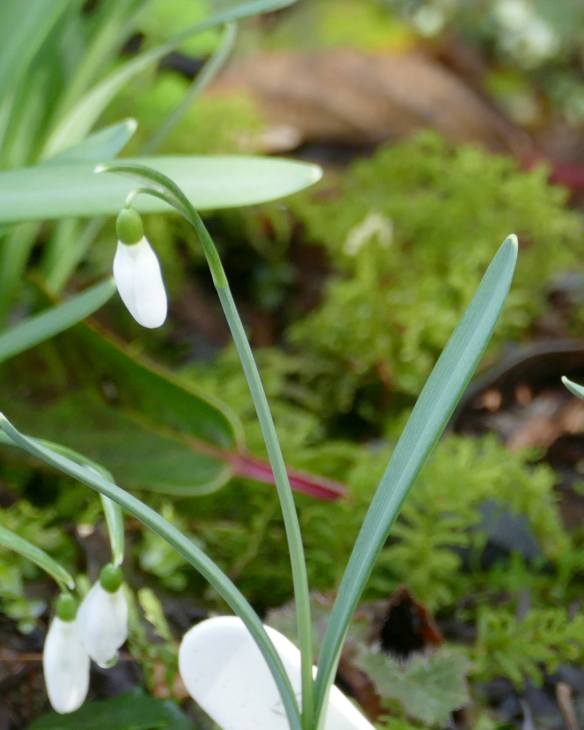
_________
_____________________
G. nivalis ‘Henry’s White Lady’. Acq. 2015. A poculiform variety of the species, and typically not that vigorous being this variant of nivalis. (February 20th 2017, February 17th 2018, January 27th 2019, January 31st 2020 – 224th to flower)
G. ‘Fanny’. Acq. 2017. An attractive green tipped outer segment single flowered hybrid. (February 20th 2017, February 8th 2018 – split, February 12th 2019, February 2nd 2022 – 216th to flower).
_________________
G. nivalis WHSH WTSWW TF EUA. Acq. 2016. A local form of the native species. (February 20th 2017, February 17th 2018, February 12th 2019 – 287th to flower).
______________________
G. nivalis WHSH LIA P. Acq. 2016. A local form of the species. (February 20th 2017, February 17th 2018, February 12th 2019 – 286th to flower, February 16th 2020 – 274th to flower).
________________________
G. nivalis WHSH FN LF F P. Acq. 2016. A local late flowering variety of the native species. (February 20th 2017, February 17th 2018, February 10th 2019 – 277th to flower, February 16th 2020 – 277th to flower).
G. elwesii ‘Miller’s Late’. Acq. 2012. A late flowering clone of the species, with very wide leaves. Not very vigorous. (February 23rd 2017, February 18th 2018, January 27th 2019 – 212th to flower split, February 10th 2020 – 259th to flower.).
G. nivalis WHSH R H GL D CF. Acquired 2016. February 23rd 2017 to mid March. A local form of the native species, from a location with a derelict house. (February 10th 2018, February 12th 2019 – 290th to flower, February 16th 2020 – 276th to flower)
_____________________
G. ‘Peg Sharples’. Acq. 2017. A single flowered hybrid. (February 23rd 2017, January 27th 2018, 2019 NA, February 1st 2020 – 233rd to flower, February 6th 2022 – 237th to flower)
G. lagodechianus. Acq. 2017. A single flowered species. No Flowers yet, but brighter green leaves than many G. species.(February 23rd 2017).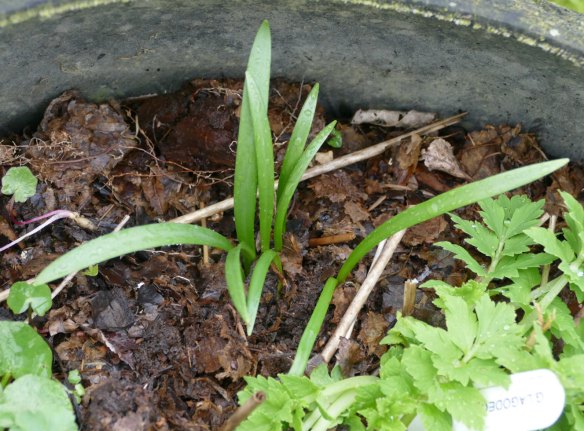
____________________
G. nivalis ex Slovakia. Acq. 2017. A European origin form of the species. (February 8th 2018, February 6th 2019, February 2nd – 2020 – 242nd to flower).
________________
G. nivalis WHSH PT CS 2. Acq 2018. Very late flowering form of the local species. (February 12th 2019, February 16 h 2020 – 272nd to flower.)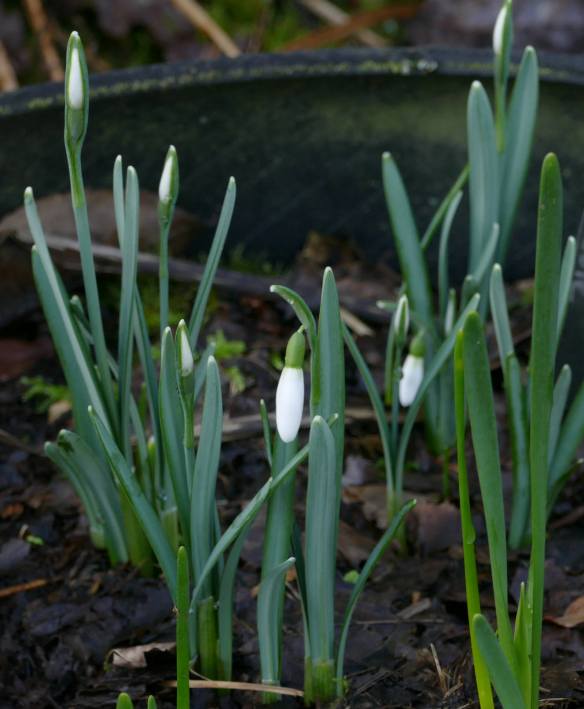
__________
G. Unknown 2-2. Acq ? March 4th 2017 to late March. A single flowered hybrid with wide plicatus type foliage.
____________________
G. nivalis WHSH PWA F CGR. Acq. 2017. A local late flowering form of the native species.(March 4th 2017).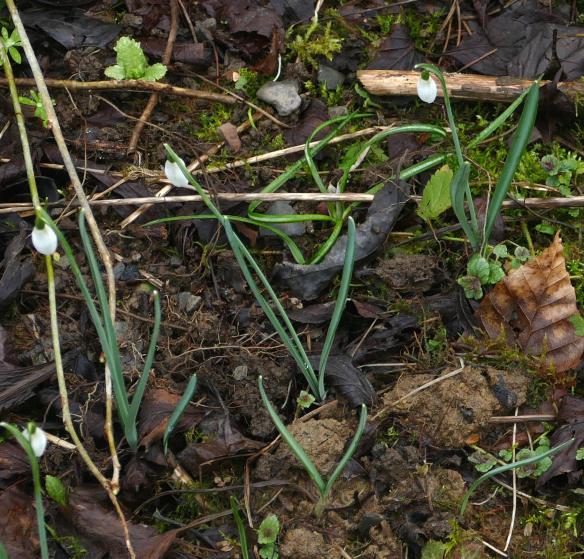
 ________________________
________________________
G. nivalis WHSH O CS F CDG. Acq. 2016. One of the latest flowering local forms of the native species, from a site very close to the sea. (March 4th 2017, February 17th 2018, February 18th 2019, February 12th 2020 – 262nd to flower).
G. x allenii. Acq.2018. An old, possibly natural, late flowering hybrid hybrid. (February 8th 2019, February 8th 2020 – 251st to flower.)
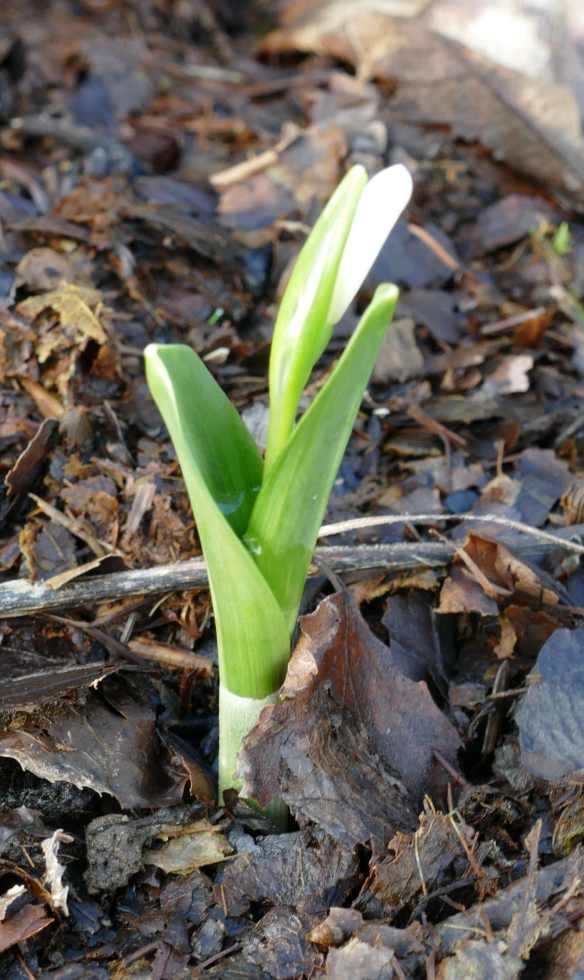
 __________________
__________________
G. elwesii ‘Hercule’. Acq. 2018. A large leaved, very late flowering form. (January 26th 2019, February 8th 2020 – 254th to flower).
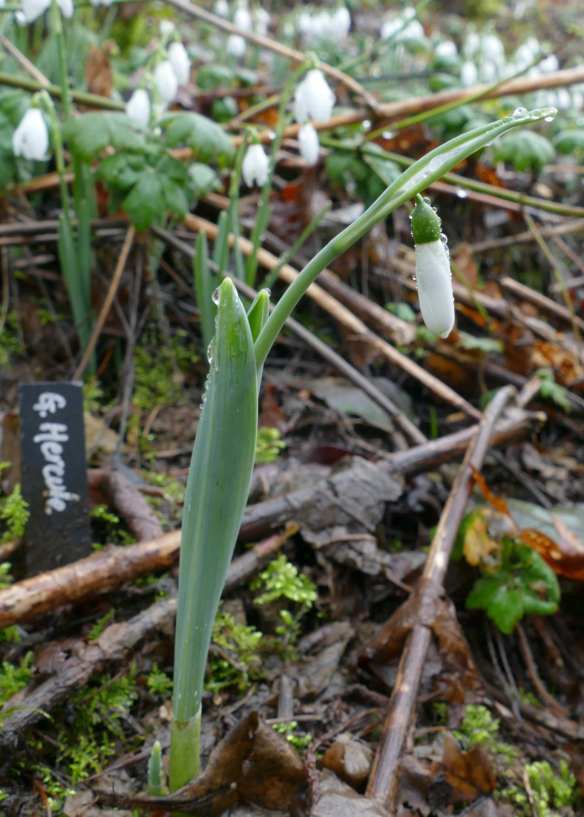

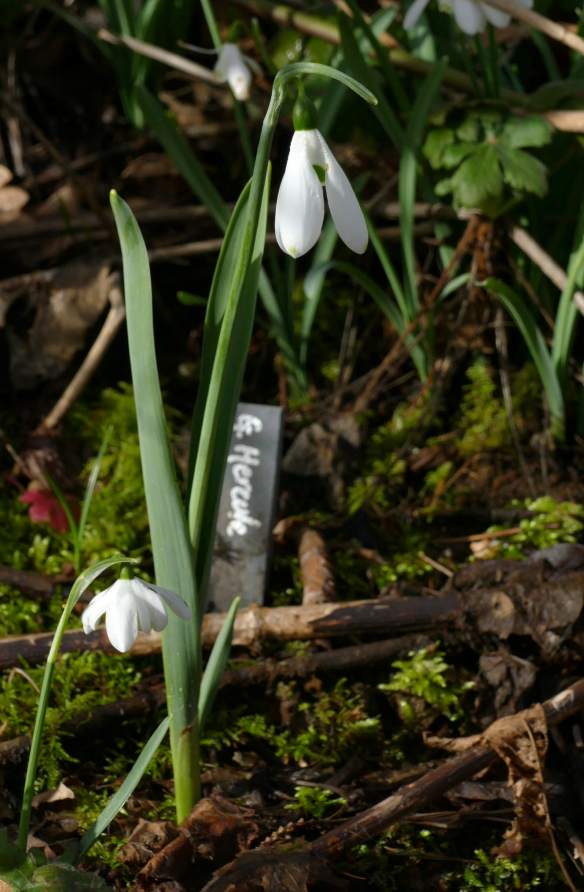
__________
G. plicatus ‘Amy Doncaster’. Acq. 2019. A late flowering form of the species with very attractive flowers. February 16th 2020 – 280th to flower.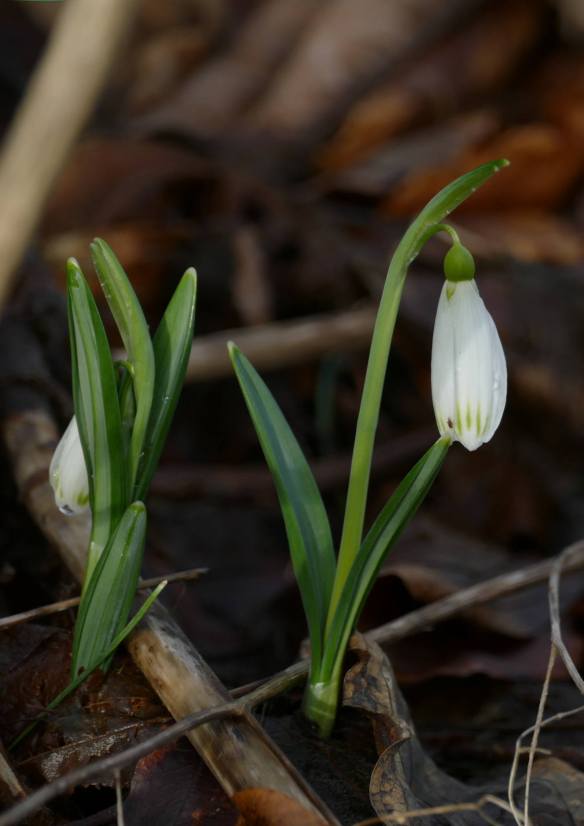
_________
G. elwesii ‘Marjorie Brown’. Acq 2013. A very slow to bulk up monostictus, single marked form of the species (January 15th 2019, February 13th 2020 – 266th to flower, January 31st 2022 – 197th to flower).
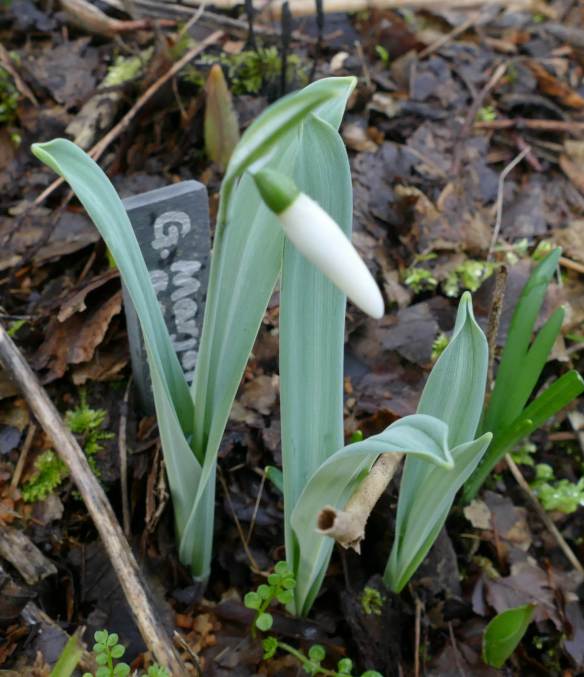
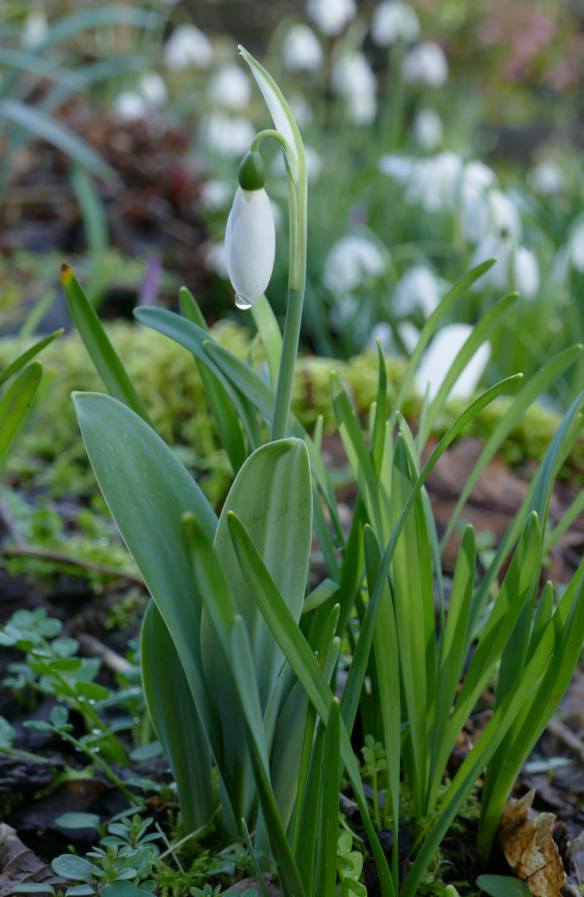
__________
G. nivalis WHSH Nr FY LDS. Acq. 2014. A later flowering form of the native species, with longish ovary and outer segments.(February 13th 2017, February 8th 2018, February 4th 2019 – part split, February 8th 2020 – 256th to flower).
_____________________
G. nivalis WHSH W R CWD BC 1. Acq. 2019. Local variant from an old site with several distinct forms, from a worker’s cottage adjacent to a large estate.
__________
G. ‘Uncle Dick’. Acq. 2015. A single flowered hybrid. No flowers or leaves since! (March 8th 2017).
________________
G. ‘Polar Bear’. Acq. 2017. A single flowered hybrid with wide foliage and smallish flowers. (March 10th 2017, February 21st 2018 – split, February 12th 2019).

